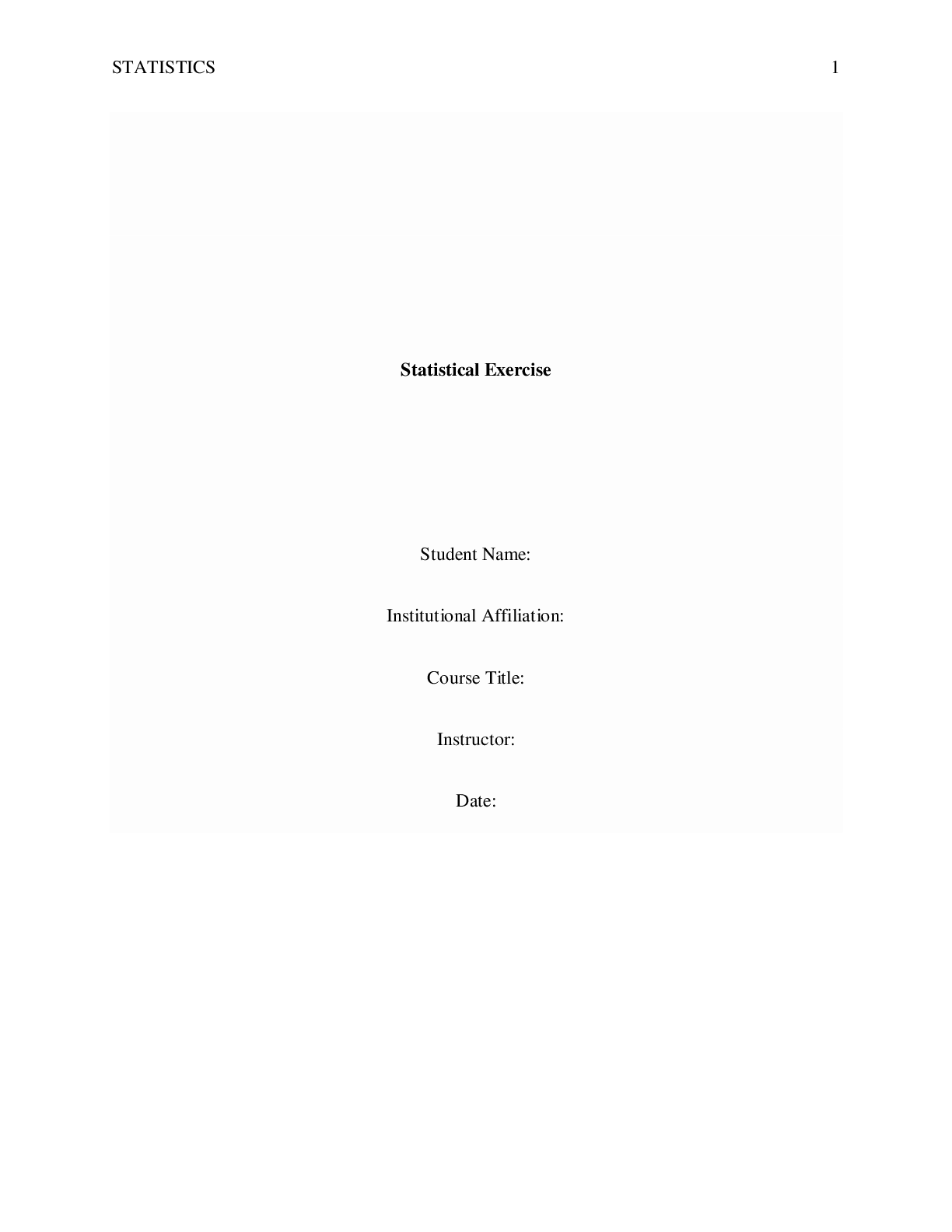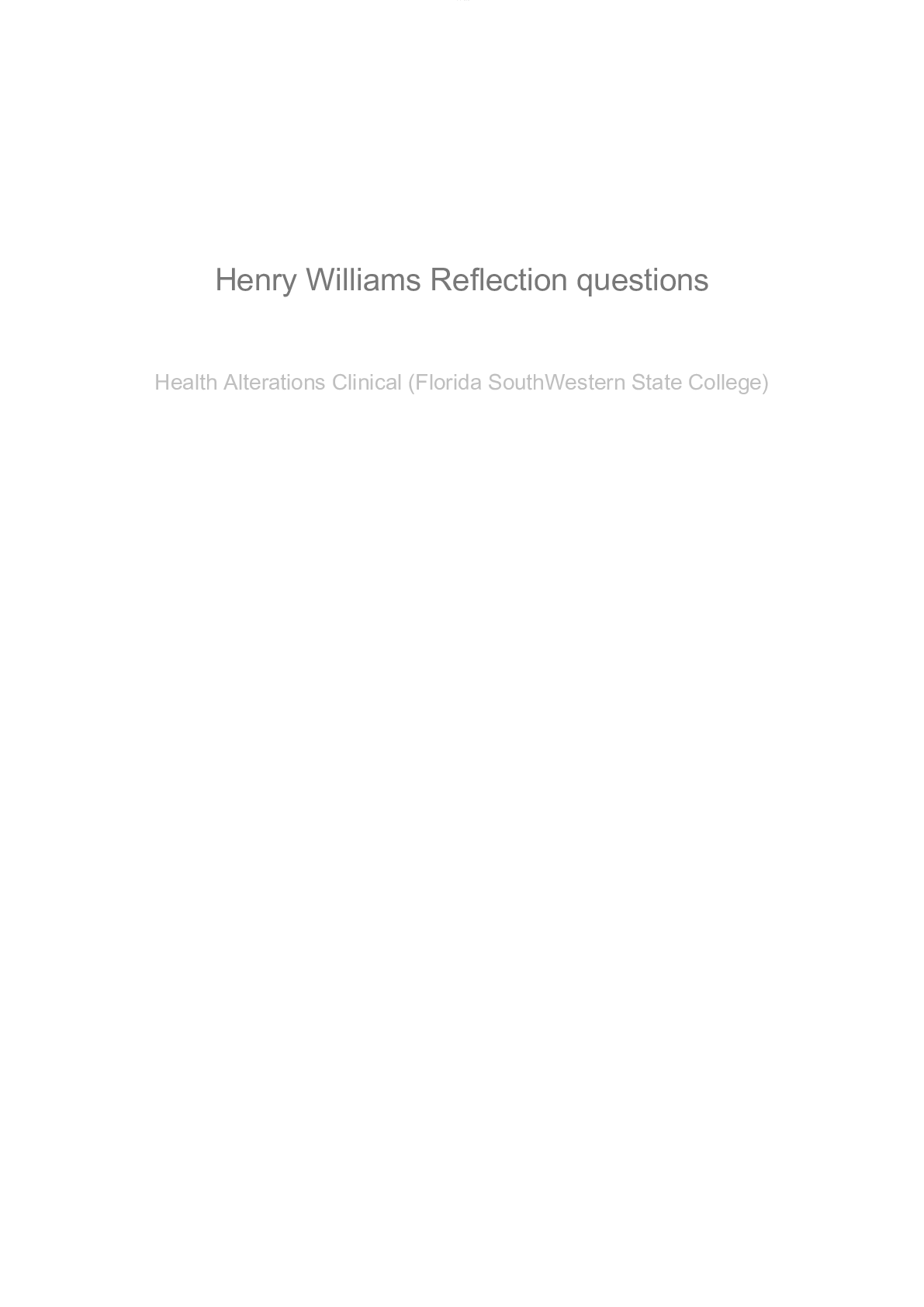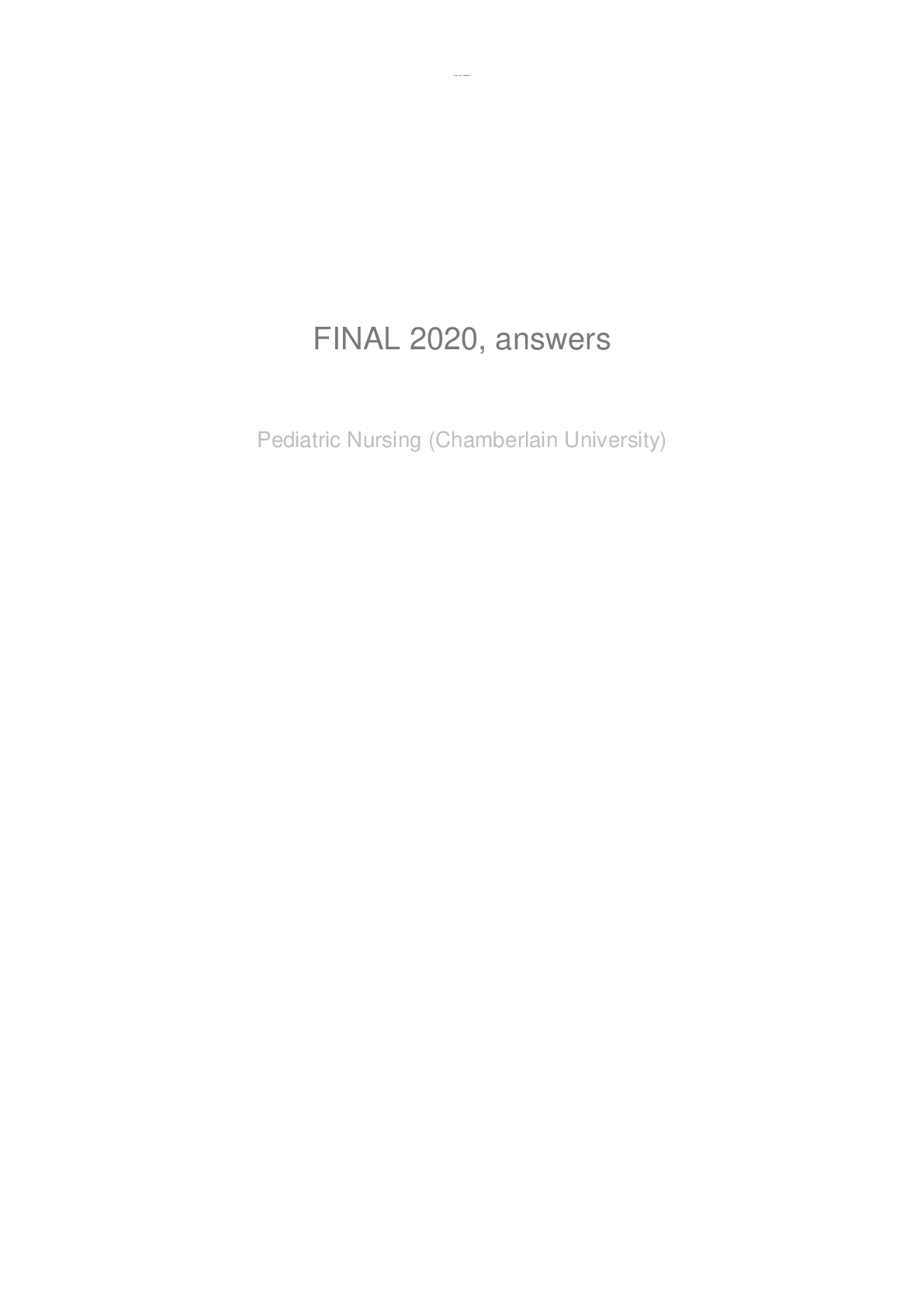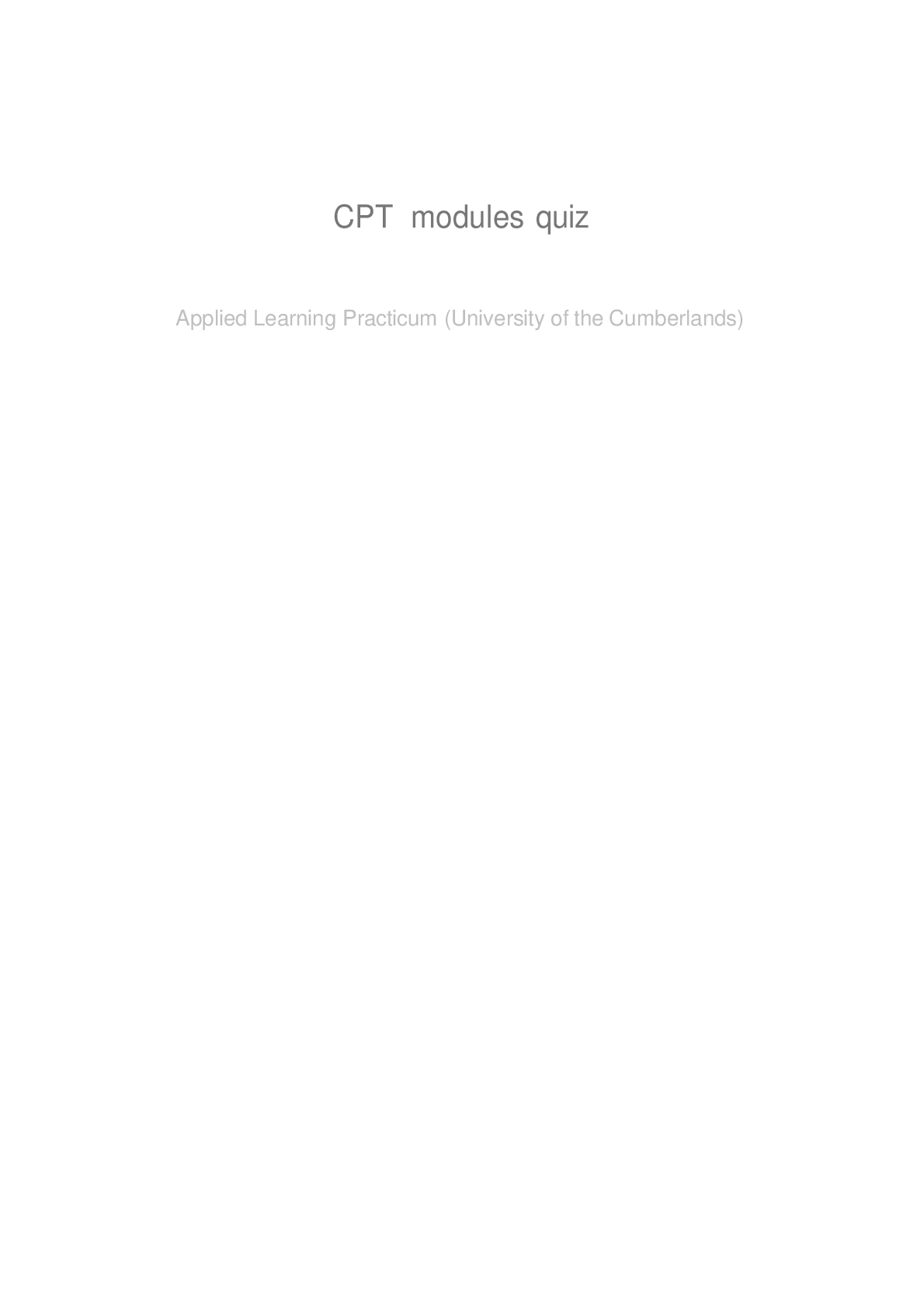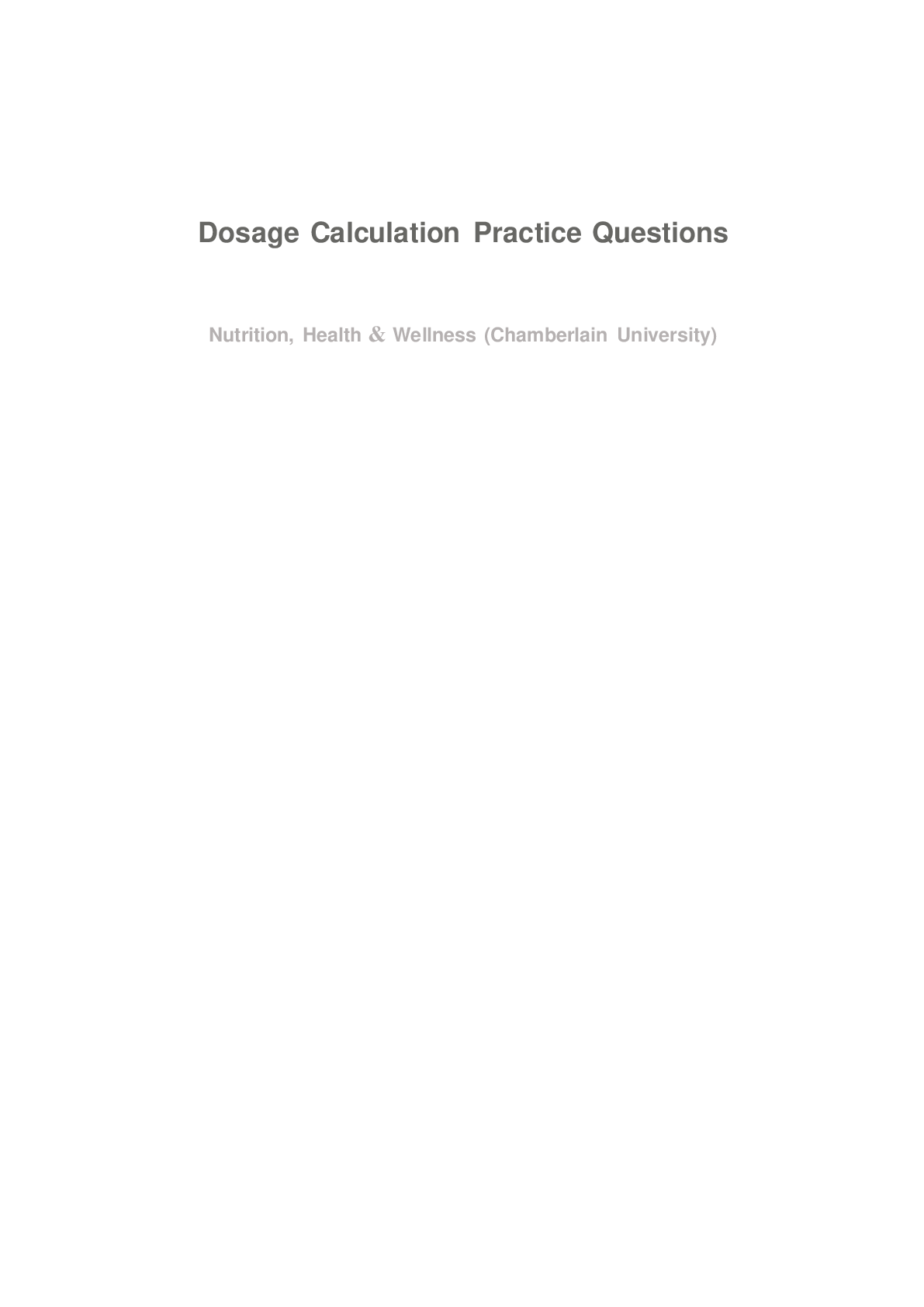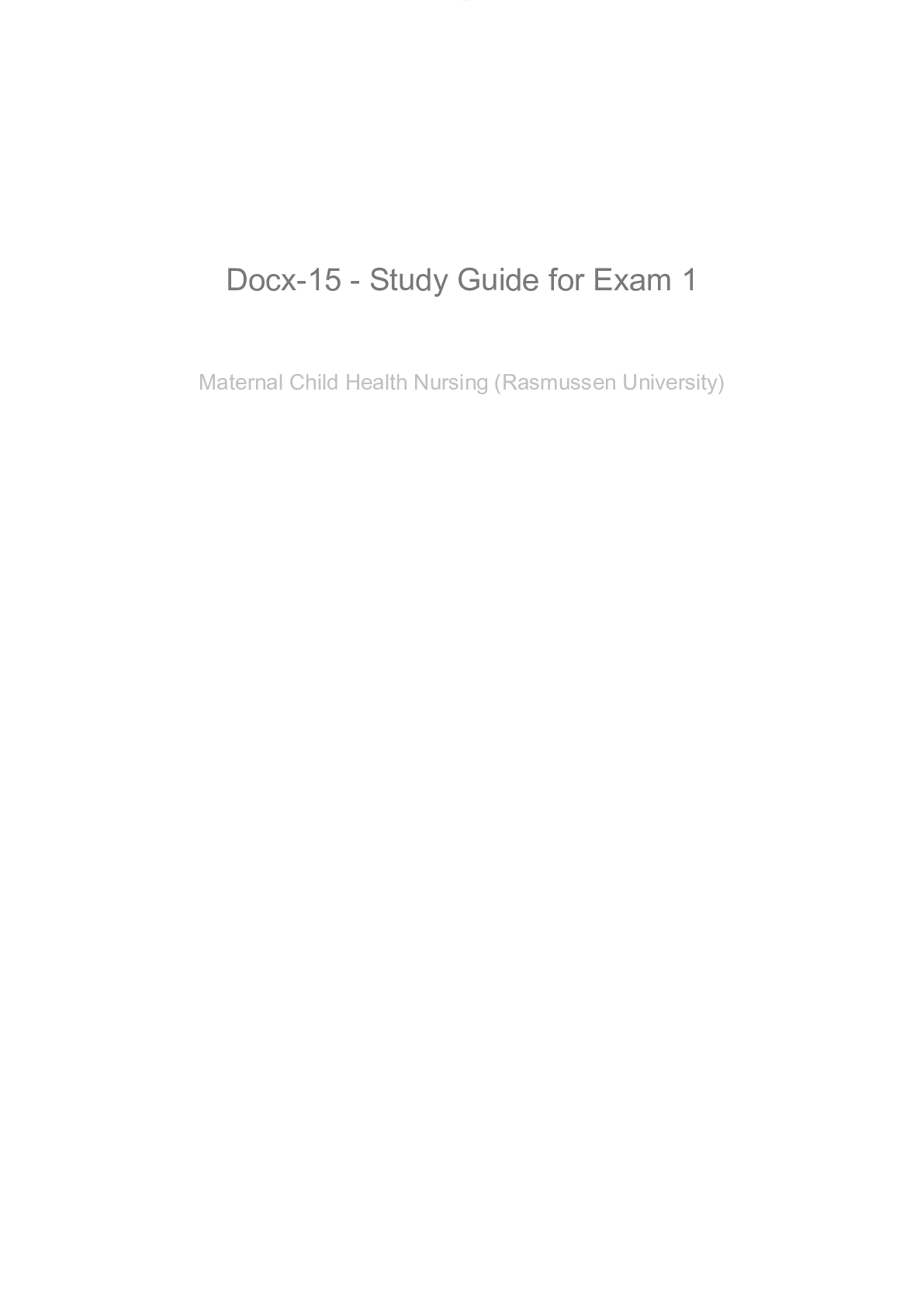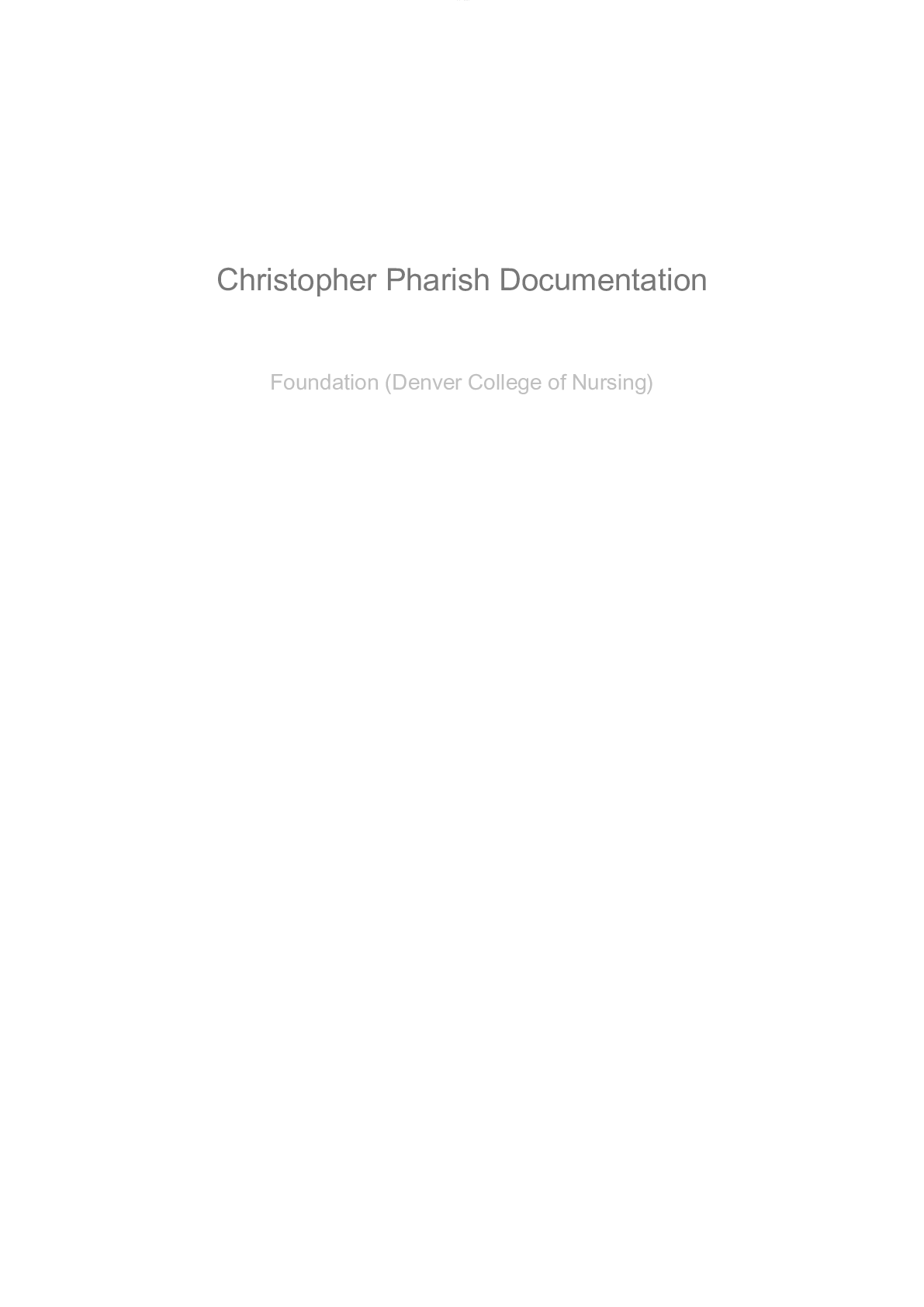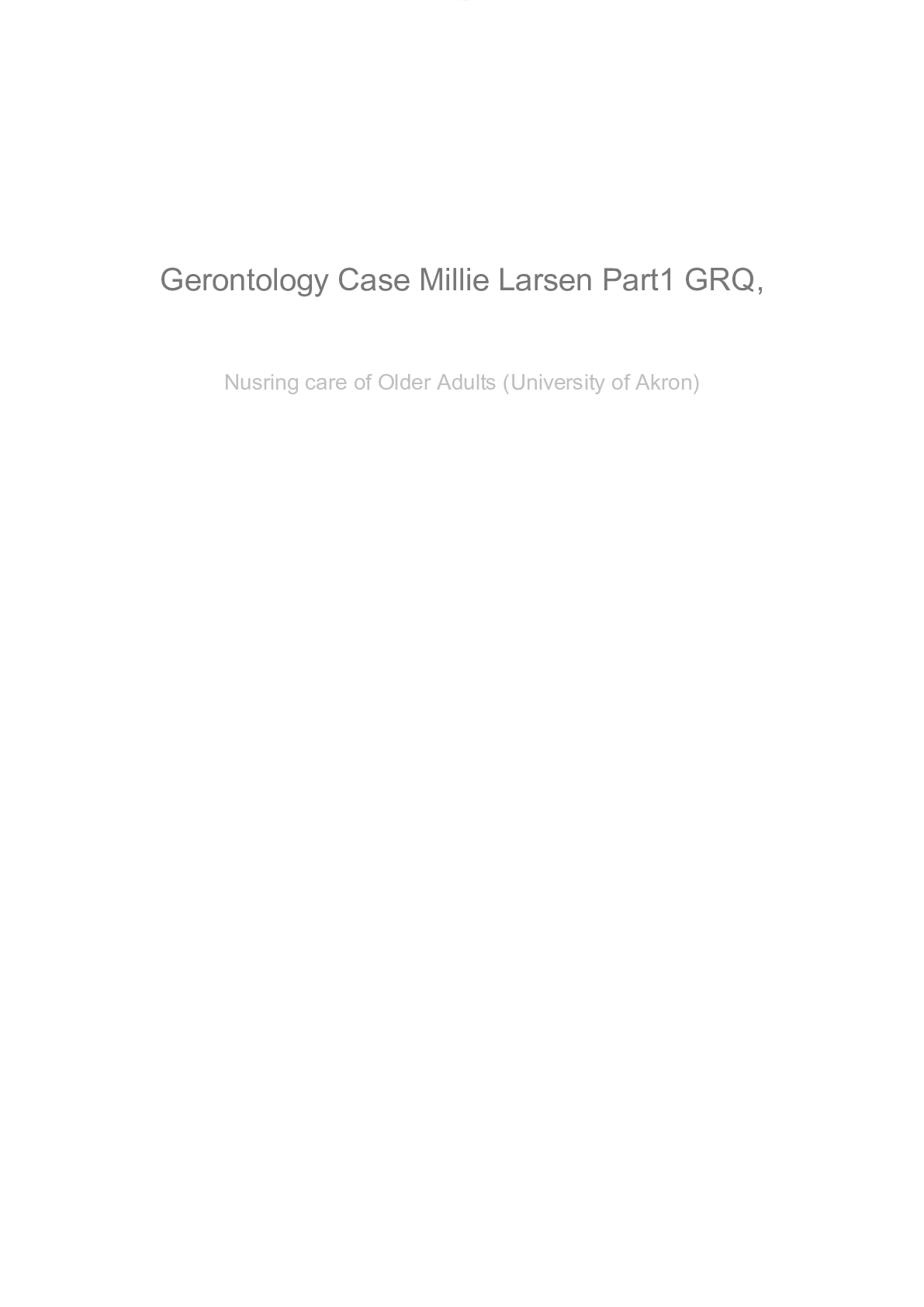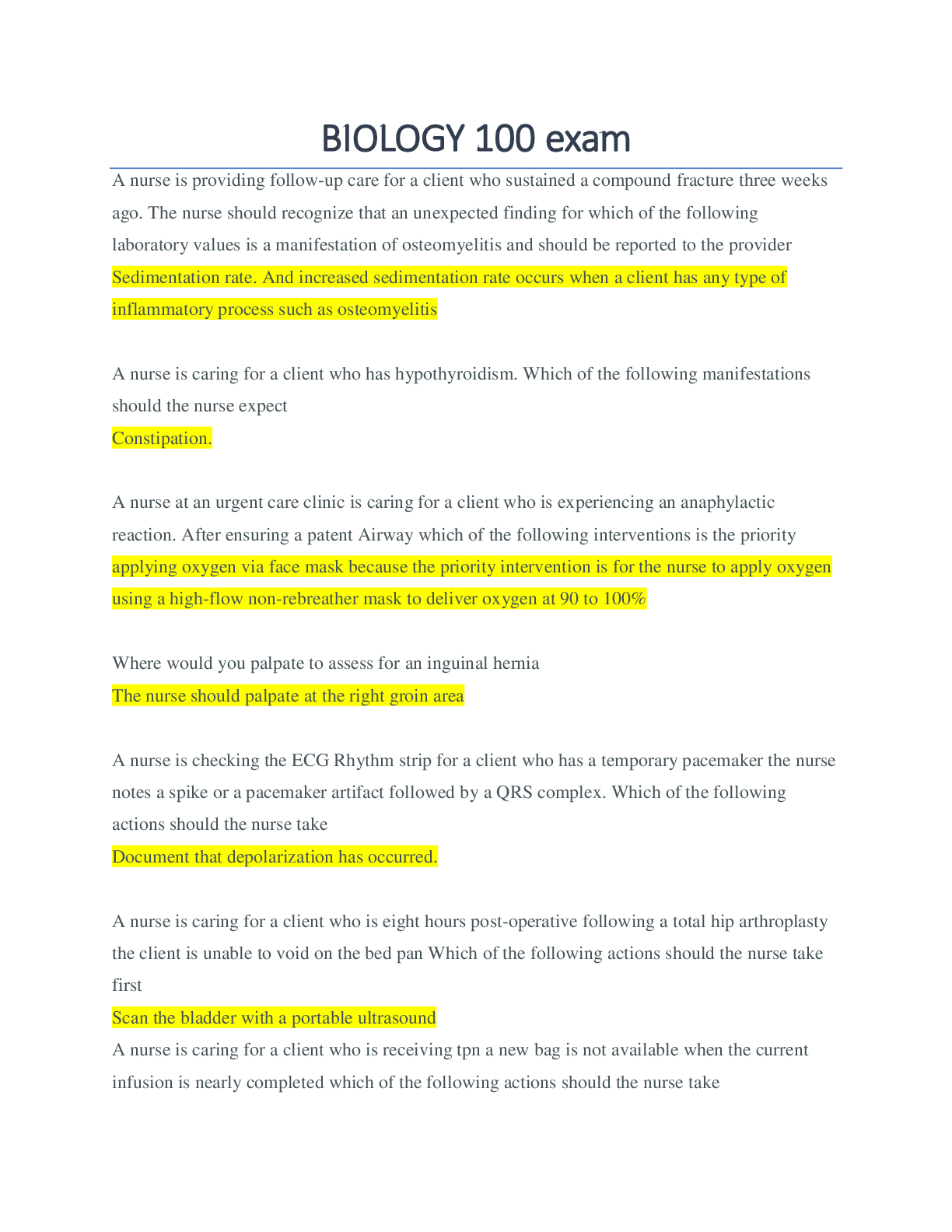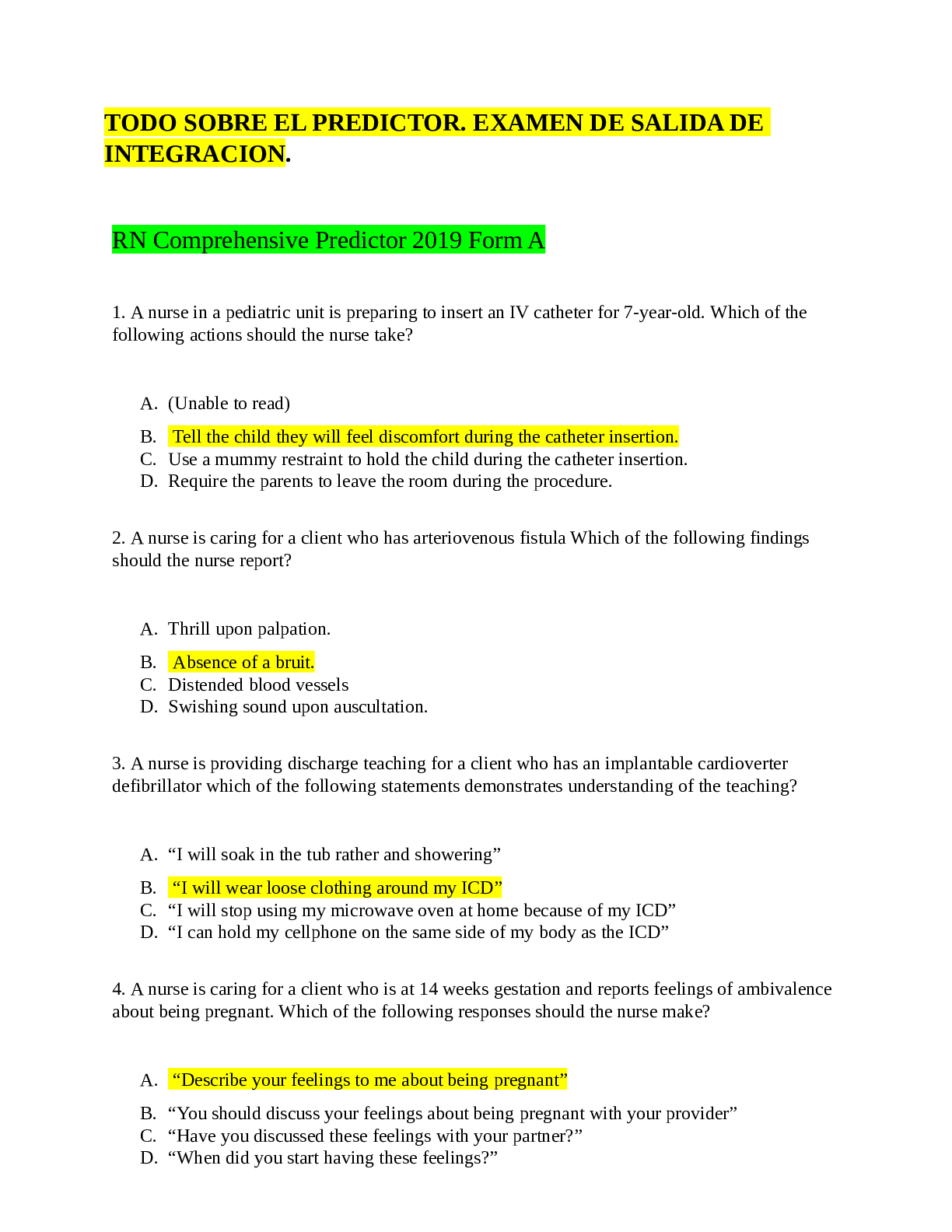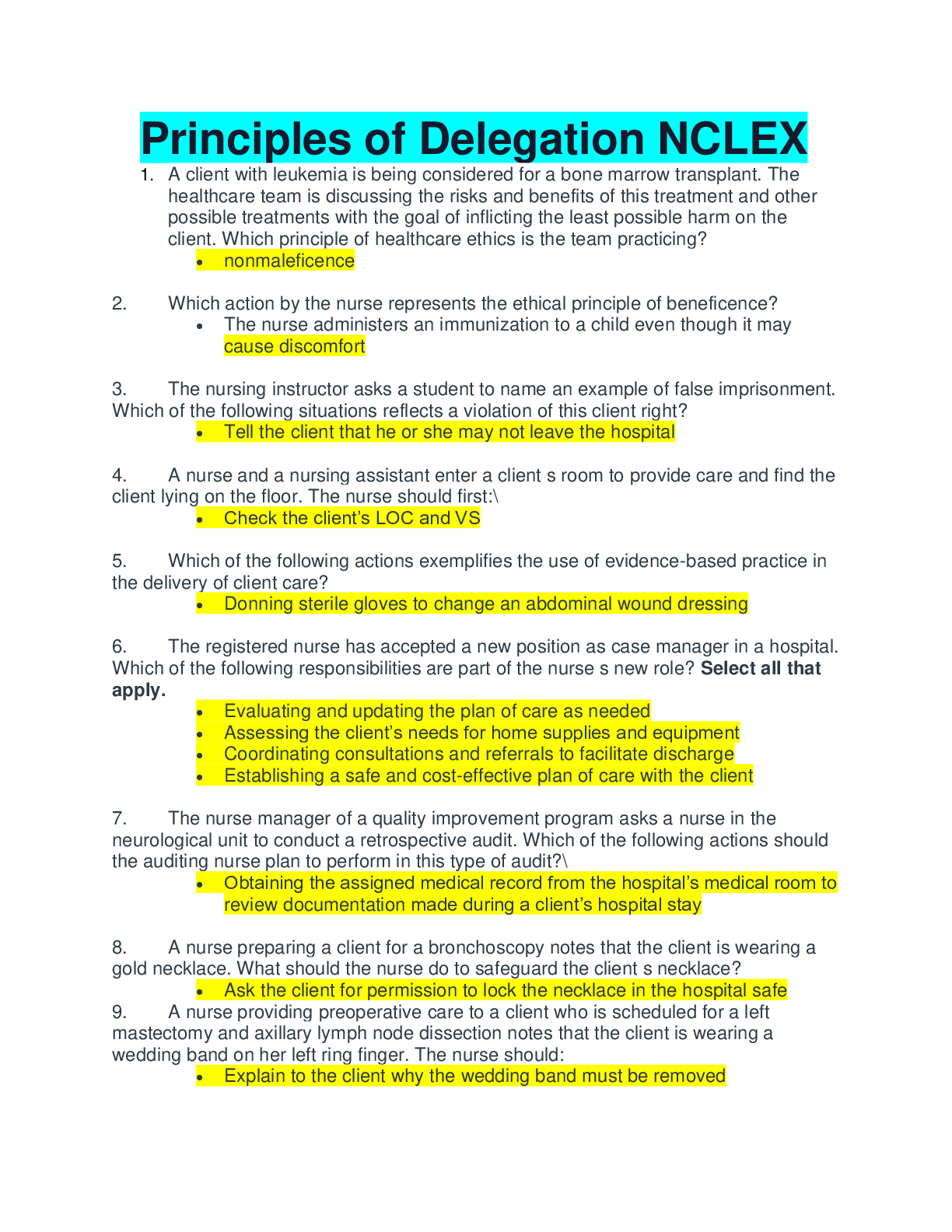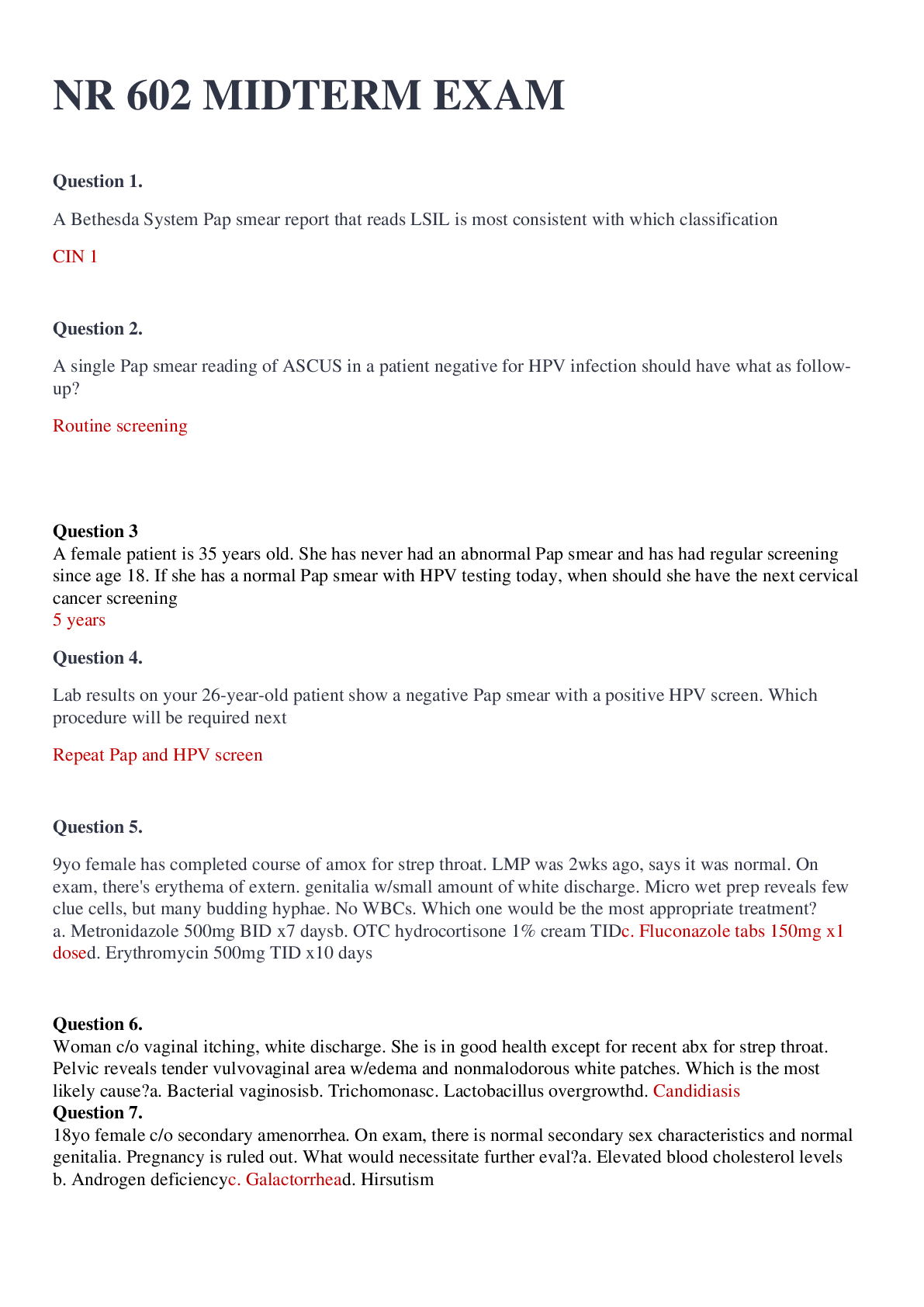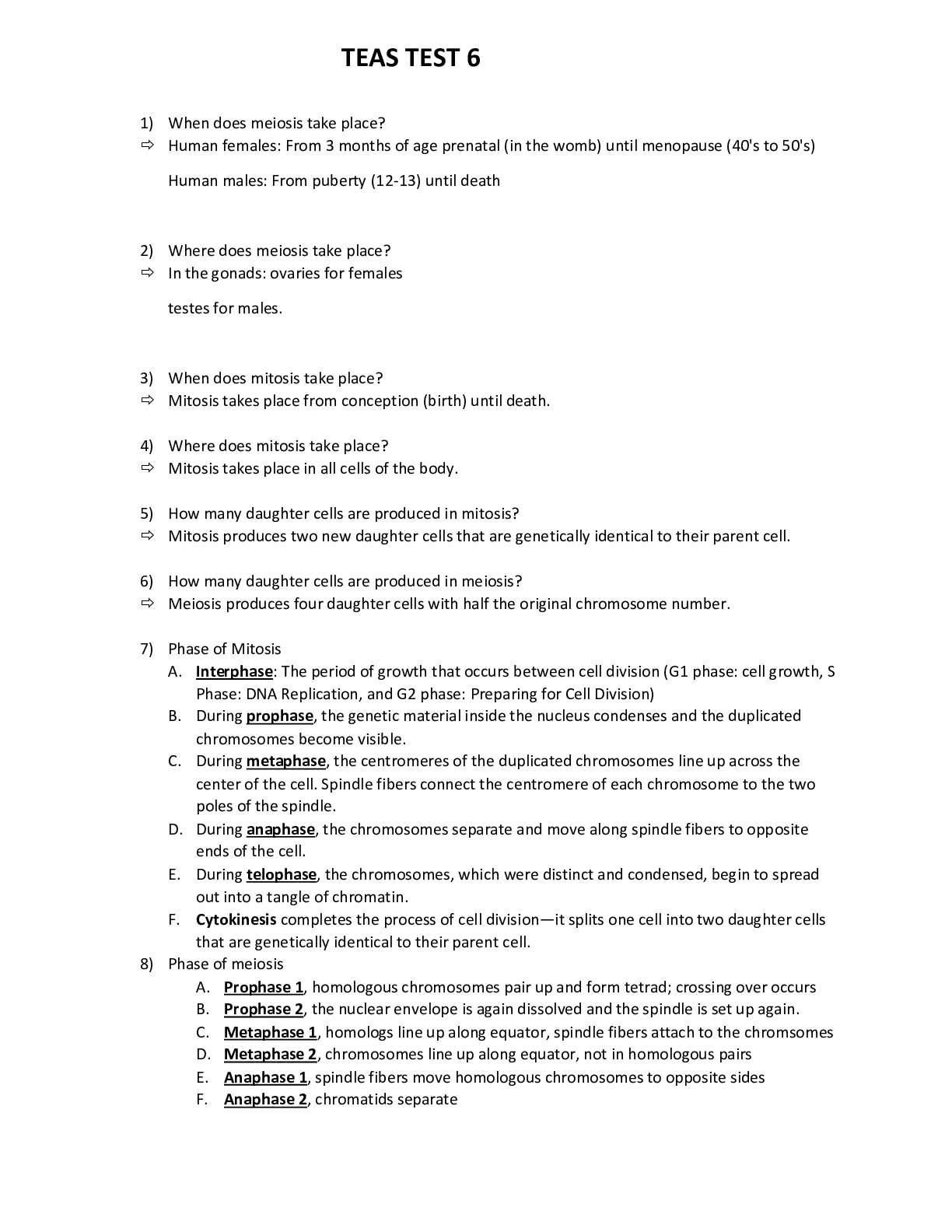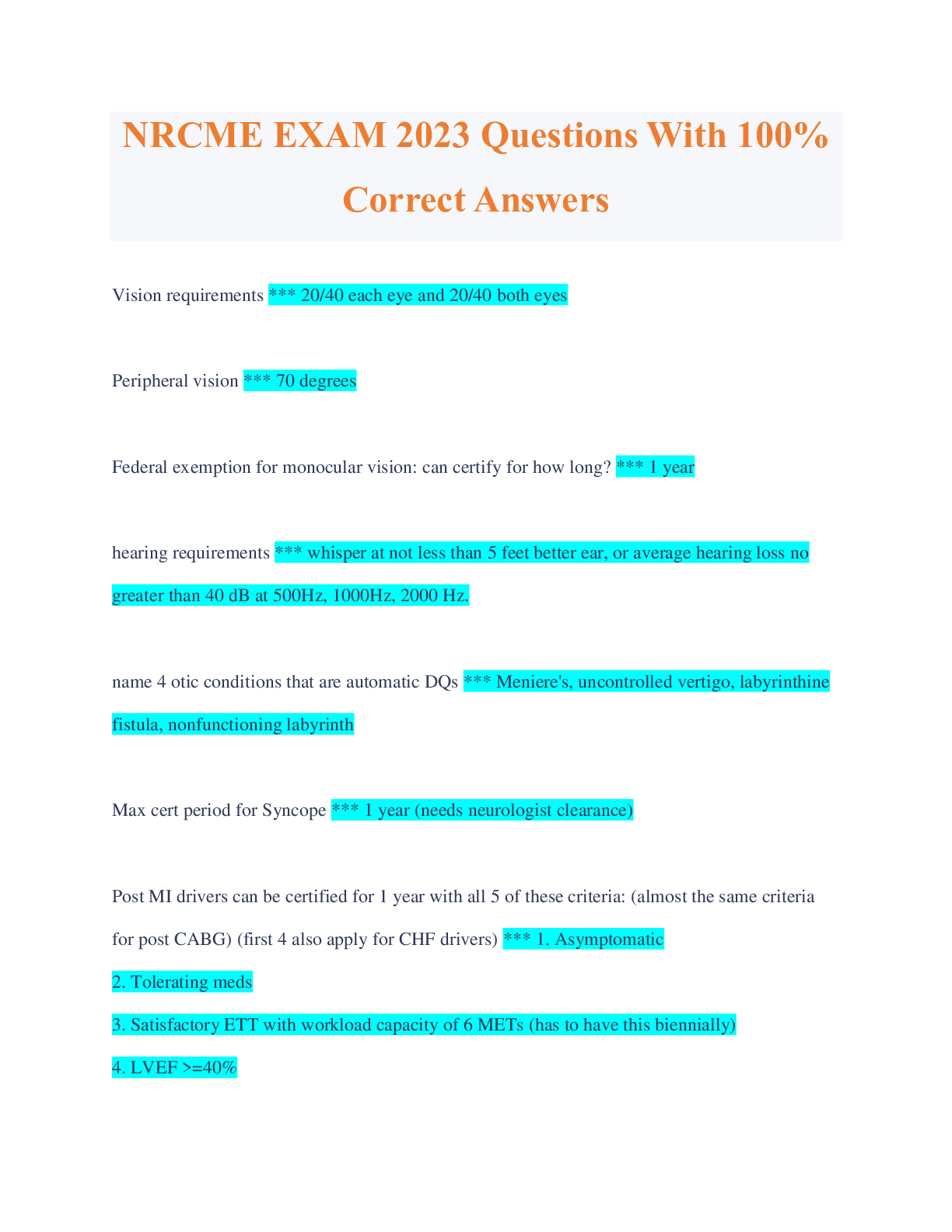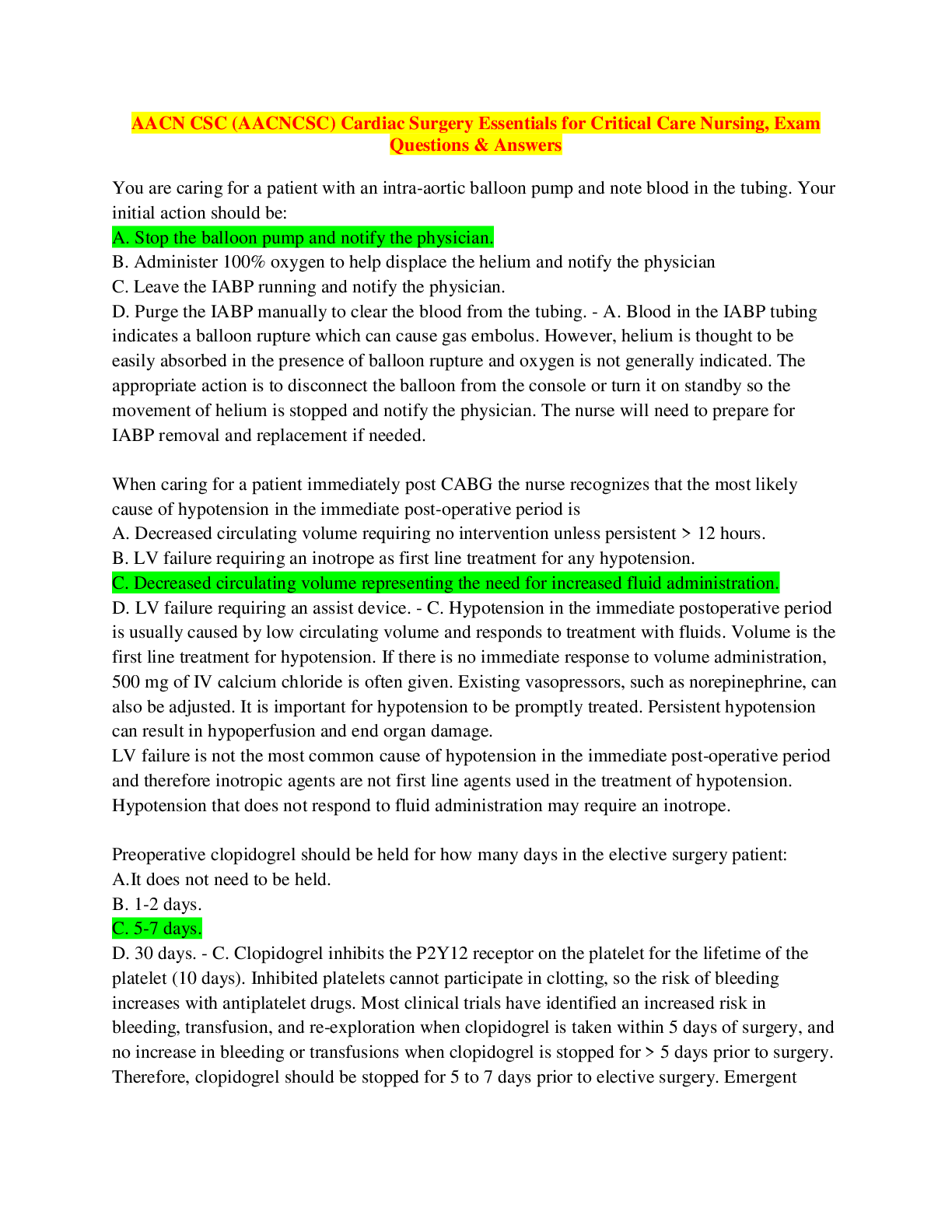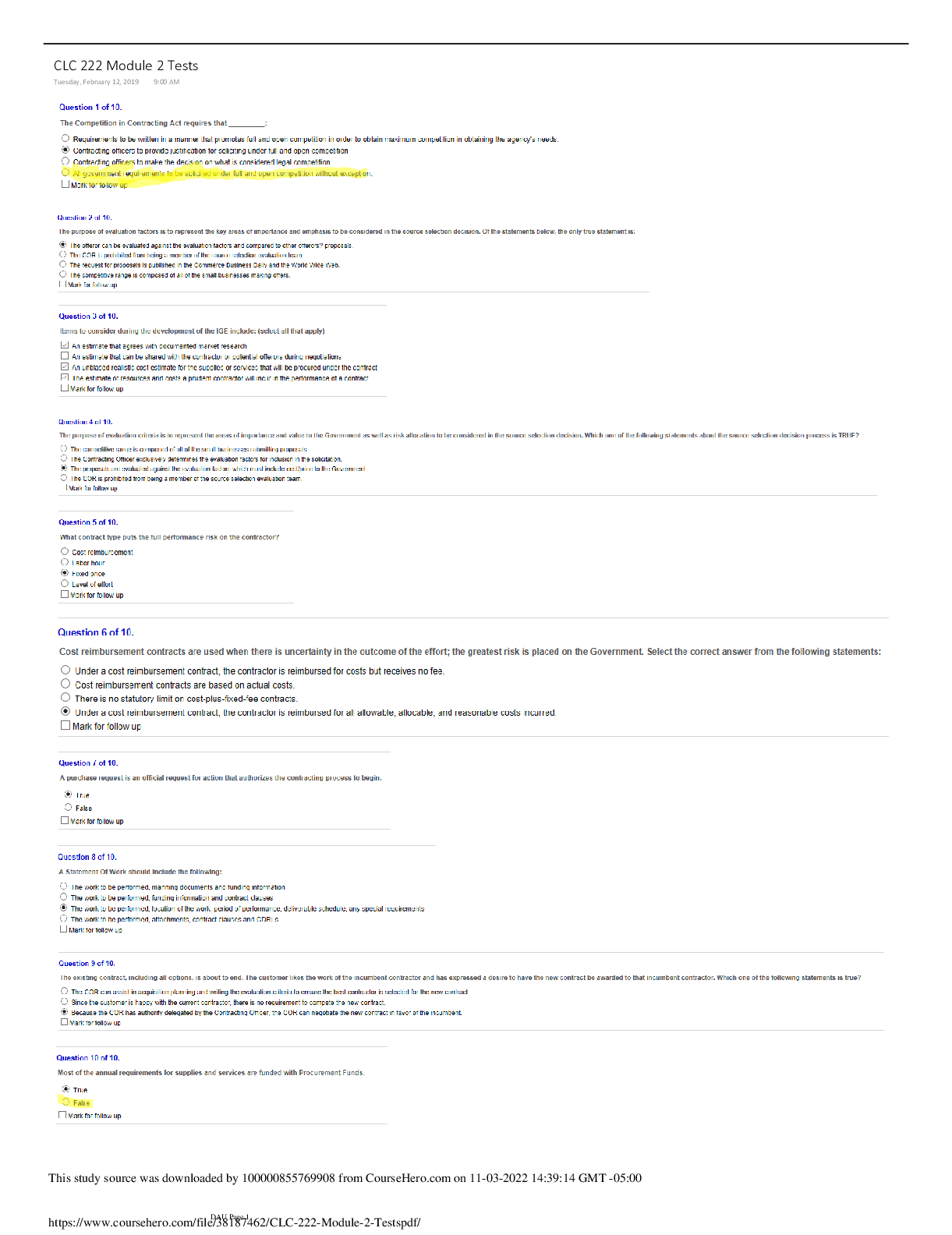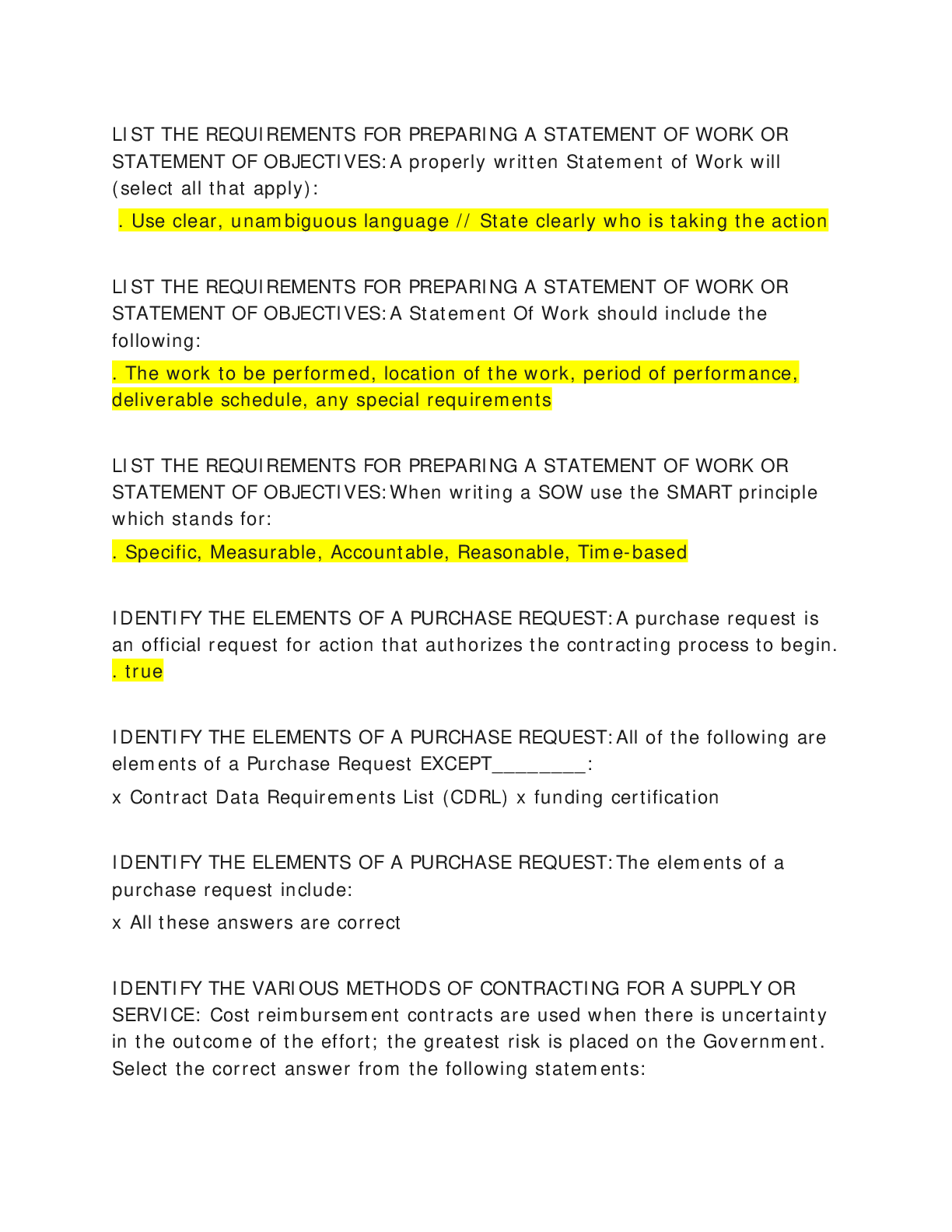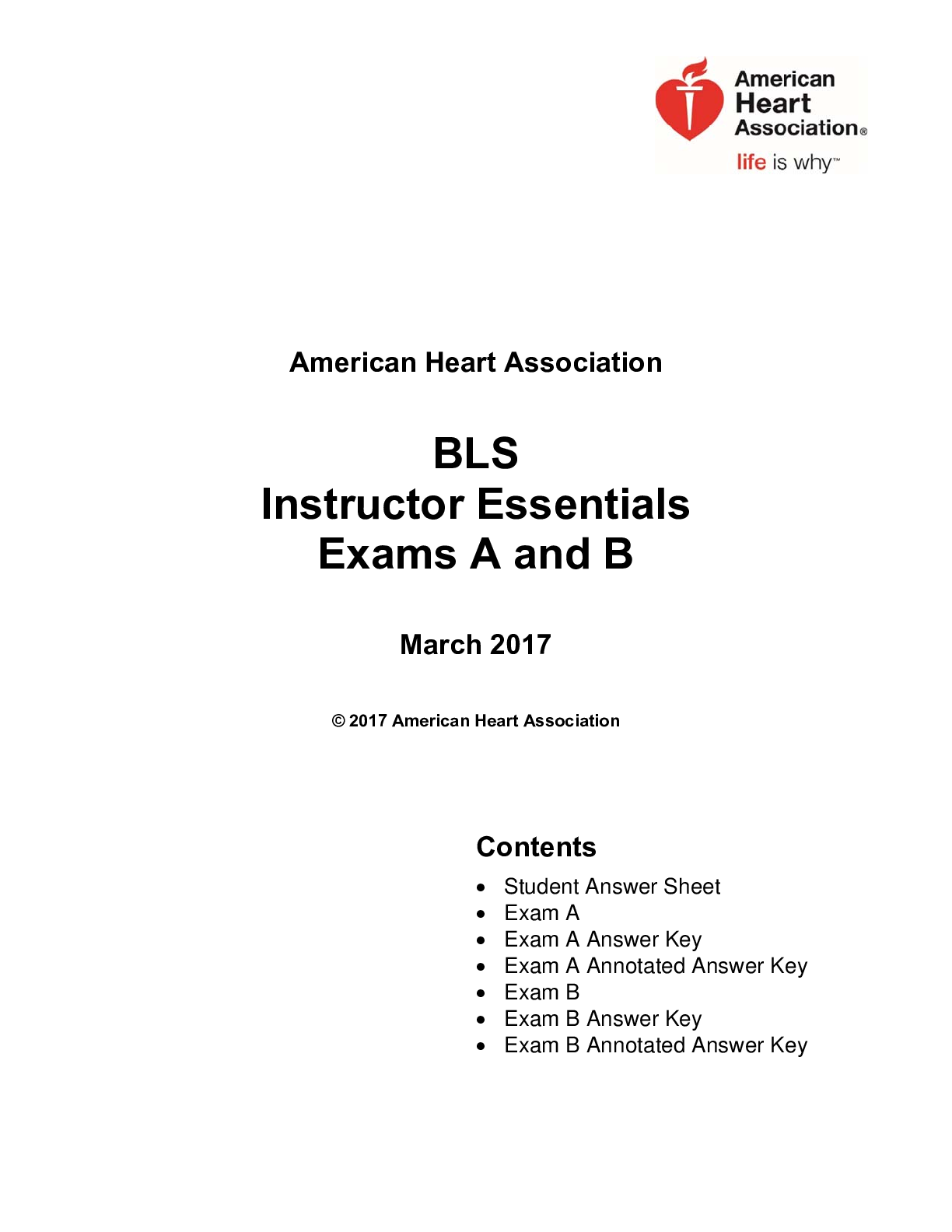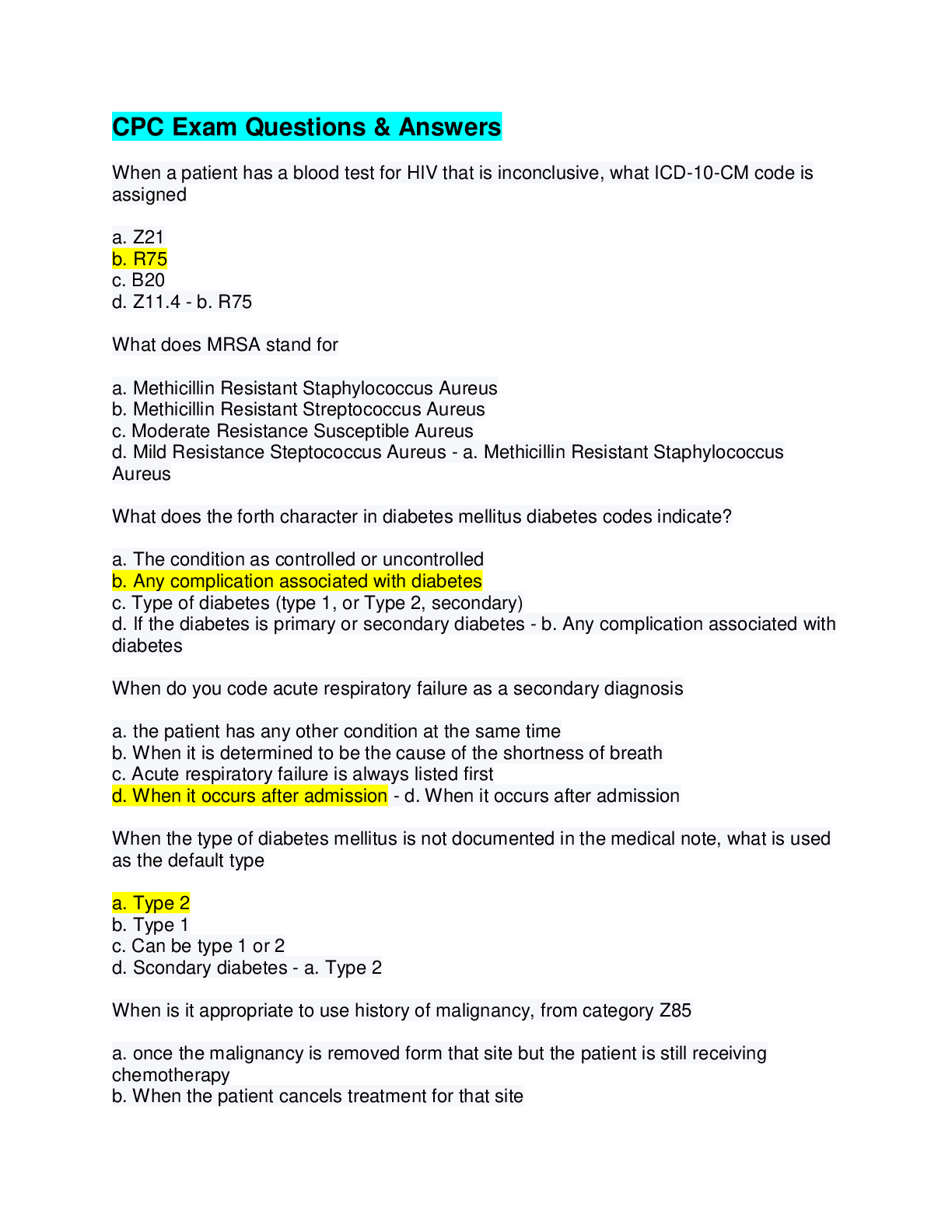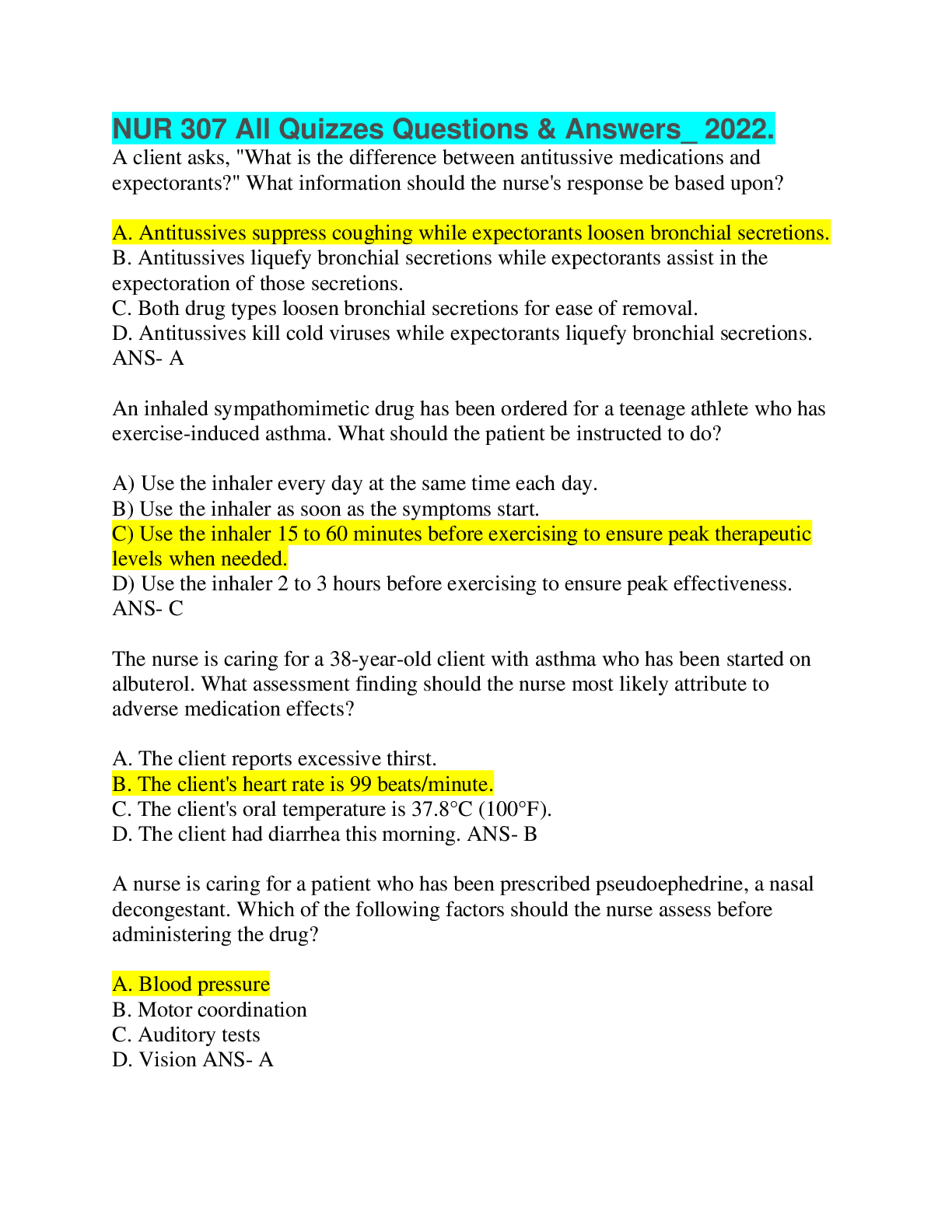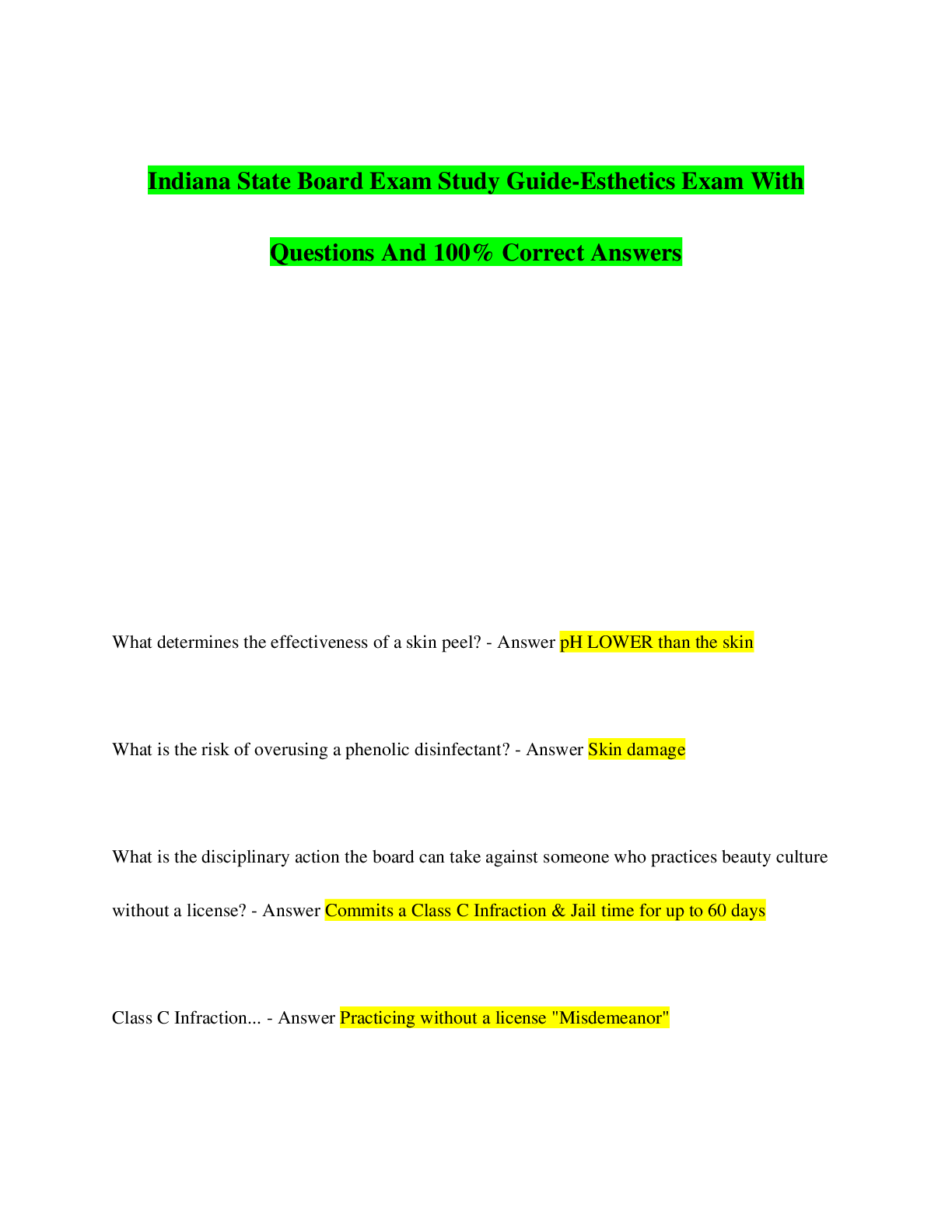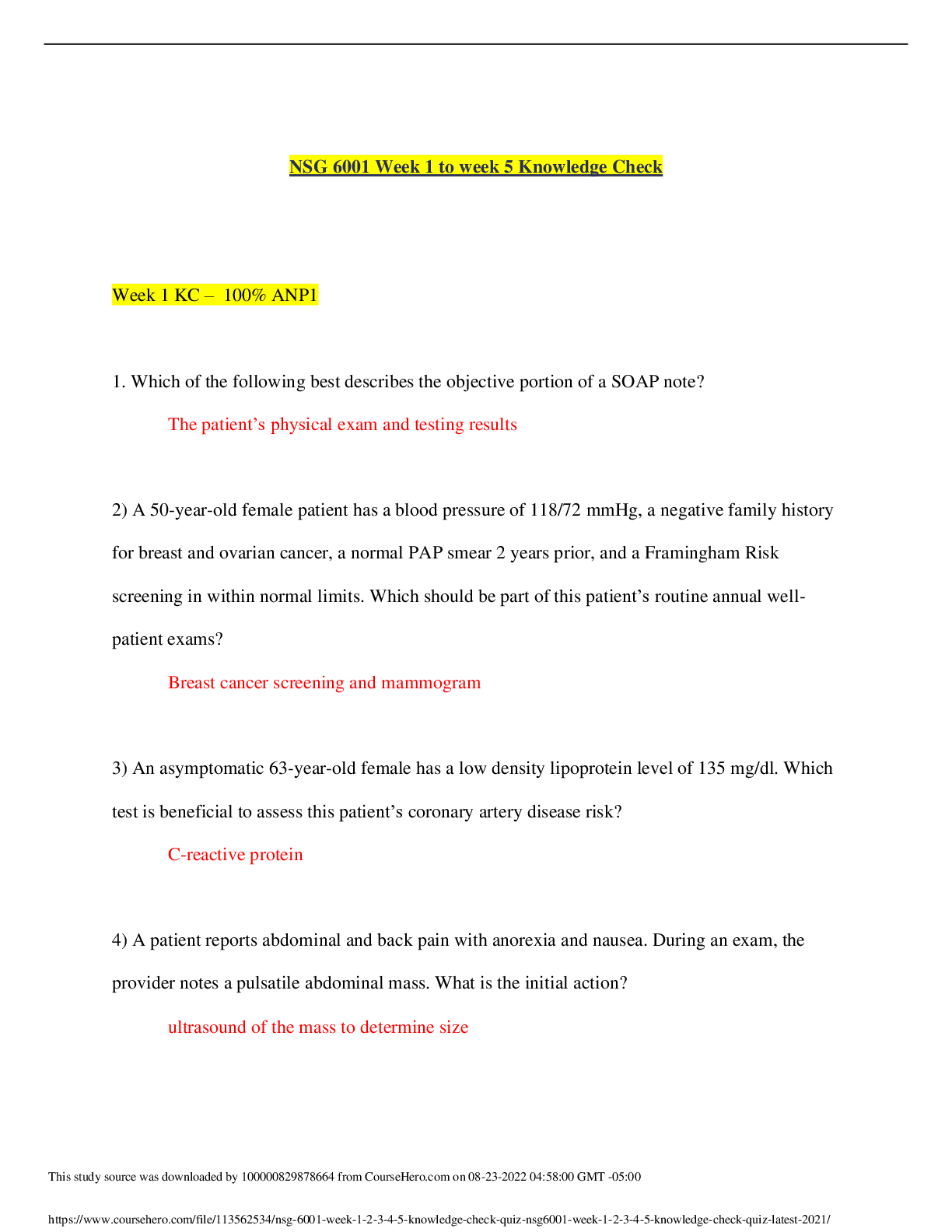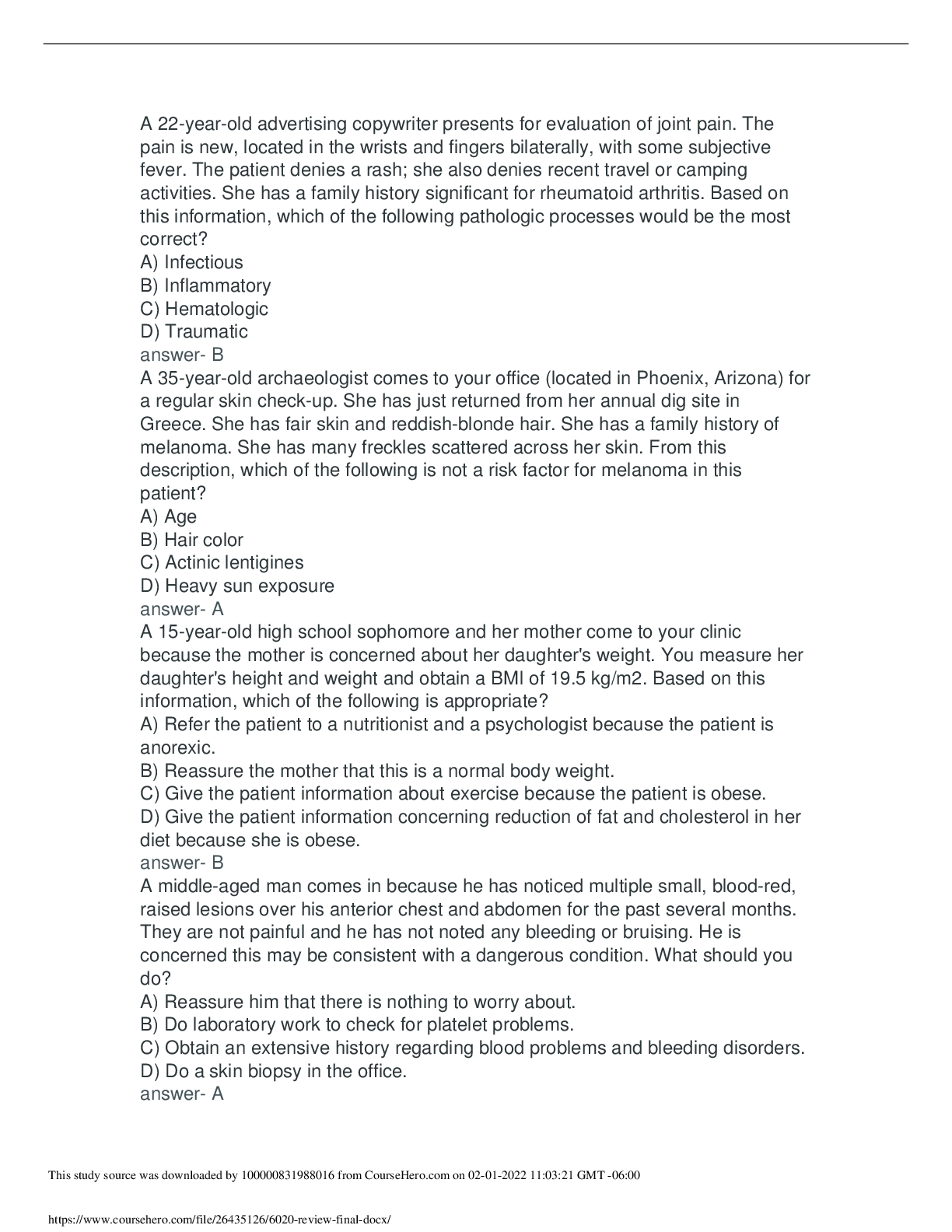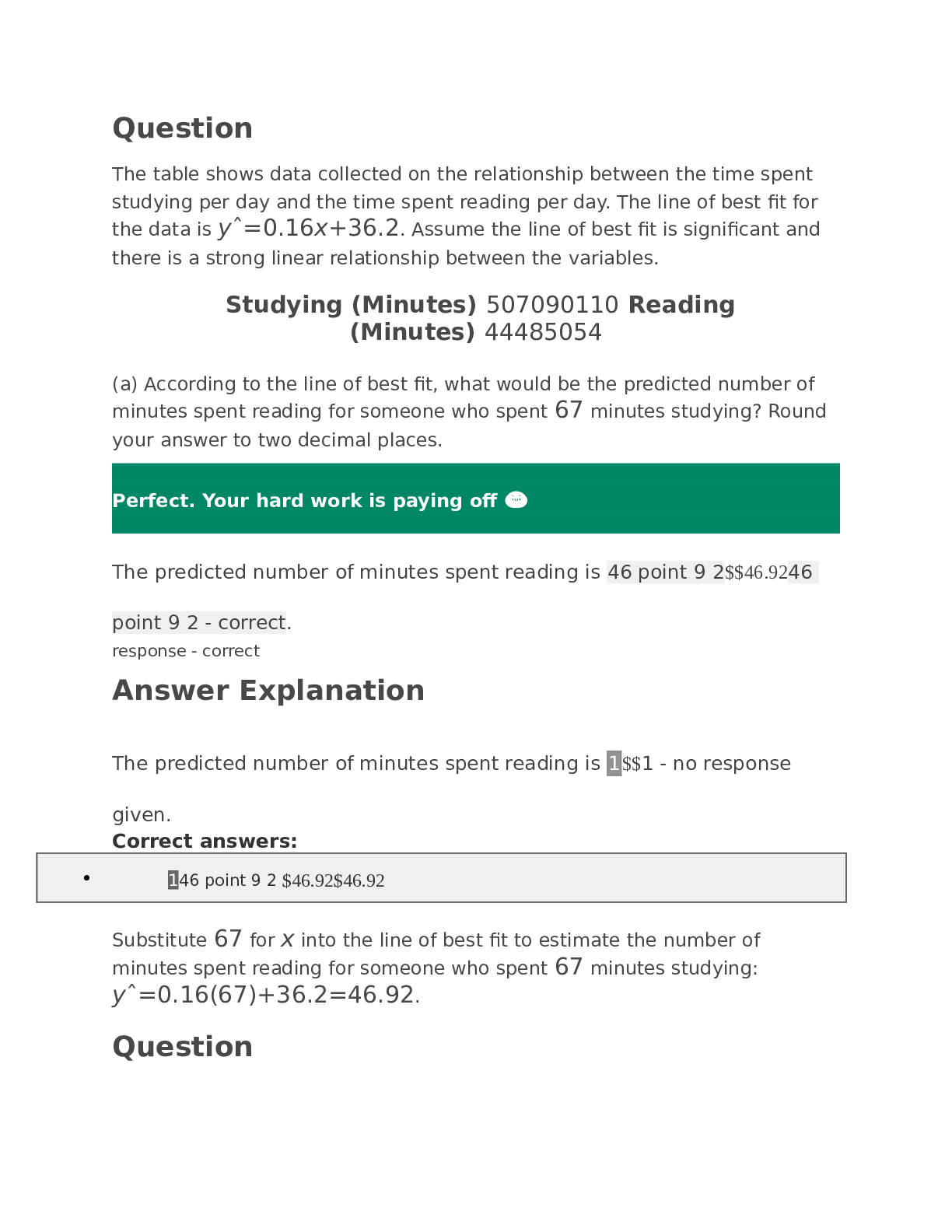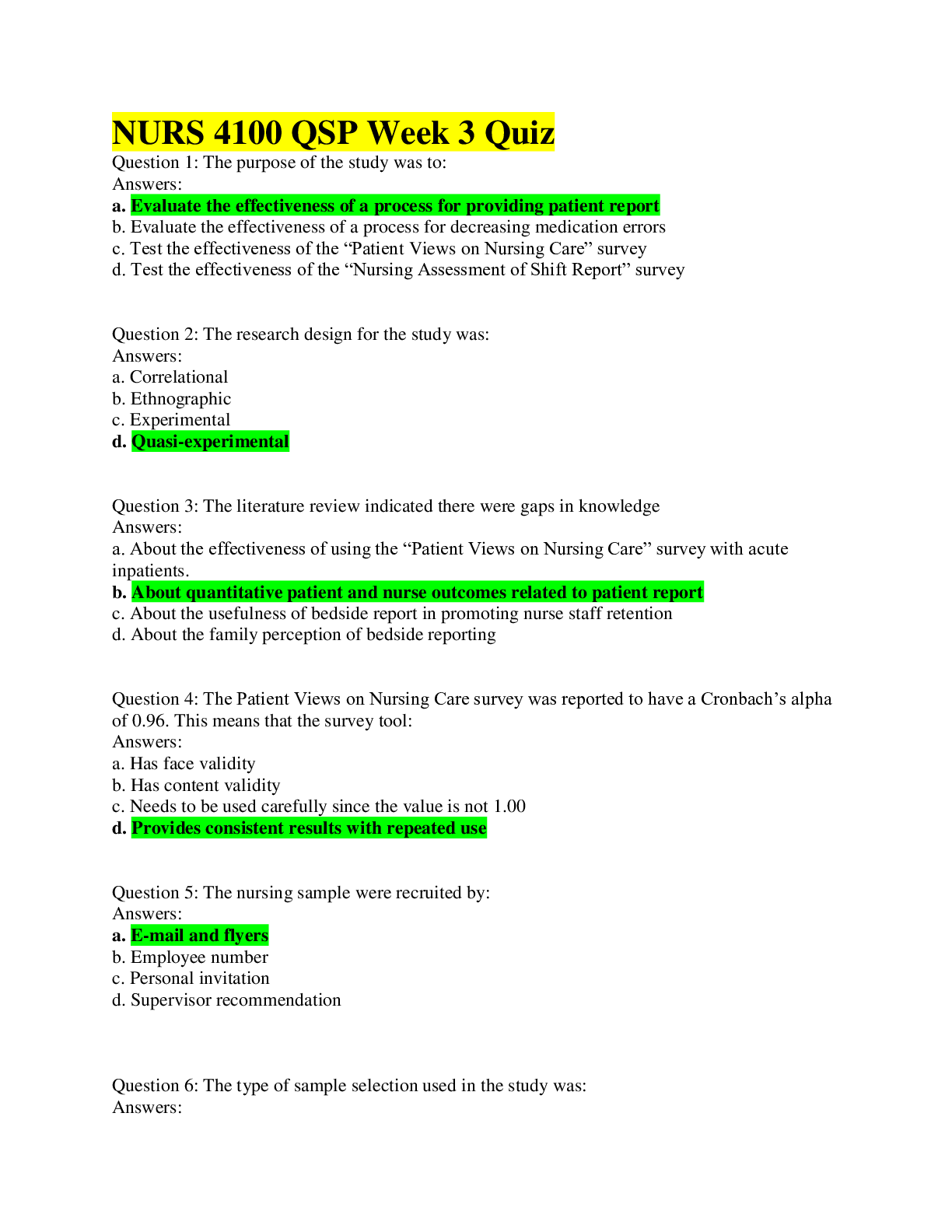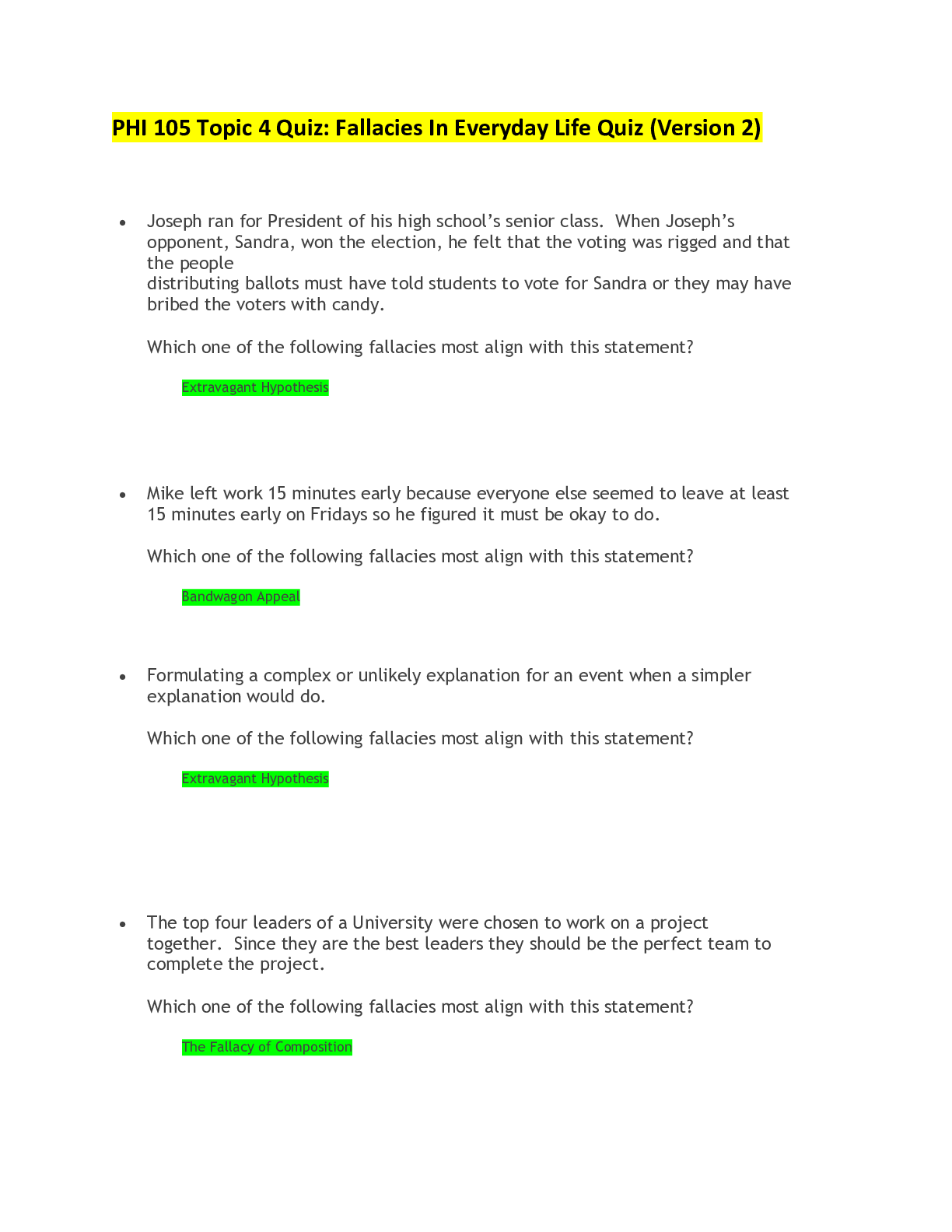*NURSING > QUESTIONS & ANSWERS > COMPLETE NEW GENERATION(NGN) NCLEX 150 QUESTIONS & Answers FOR 2023 EXAM! 100% CORRECT ANSWERS (All)
COMPLETE NEW GENERATION(NGN) NCLEX 150 QUESTIONS & Answers FOR 2023 EXAM! 100% CORRECT ANSWERS
Document Content and Description Below
The New Gen Nclex has 150 questions 1. A nurse is caring for a patient with diabetes. Which of the following actions should the nurse take when administering insulin? Select all that apply. A. Verify ... the correct dose with another nurse. B. Administer insulin via intramuscular injection. C. Monitor the patient's blood glucose level. D. Check the expiration date of the insulin 2. A nurse is caring for a patient with hypertension. Which of the following lifestyle modifications should the nurse recommend to the patient? Select all that apply. A. Limit sodium intake. B. Increase physical activity. C. Reduce caffeine intake. D. Avoid alcohol consumption. 3. A nurse is assessing a patient who is receiving chemotherapy. Which of the following symptoms should the nurse report to the healthcare provider? Select all that apply. A. Nausea and vomiting. B. Fatigue and weakness. C. Hair loss. D. Dry mouth and difficulty swallowing. 4. A nurse is caring for a patient with a history of heart failure. The patient's weight has increased by 5 pounds over the past week. Which of the following actions should the nurse take? Select 2. A. Increase the patient's diuretic dose. B. Restrict the patient's sodium intake. C. Increase the patient's fluid intake. D. Administer oxygen therapy. 5. A nurse is caring for a patient who has just undergone surgery. Which of the following interventions should the nurse take to prevent complications? Group 1: Respiratory interventions. Group 2: Circulatory interventions. Group 1: A. Administer oxygen therapy. B. Encourage deep breathing and coughing exercises. C. Use an incentive spirometer. Group 2: D. Apply compression stockings. E. Monitor vital signs. F. Administer anticoagulant therapy. 6. Drag-and-drop: Cloze: a. Question: A nurse is caring for a patient with a new diagnosis of diabetes. Drag and drop the steps for checking blood glucose levels in the correct order. b. Wash hands. c. Insert test strip into the meter. d. Prick finger with lancet. e. Apply blood to the test strip. Read and record the blood glucose level. 11. Answer: 1, 3, 4, 2, 5. Drag-and-drop: Rationale: 12. Question: A nurse is caring for a patient who has just undergone a total hip replacement. Drag and drop the interventions in the order of priority. 13. Administer pain medication. 14. Encourage the use of a continuous passive motion (CPM) machine. 15. Apply ice to the surgical site. Assist the patient with ambulation. Rationale: 16. Answer: 1, 3, 2, 4. Administering pain medication is the first priority, followed by applying ice to the surgical site to reduce swelling. Encouraging the use of a CPM machine can help prevent blood clots. Finally, assisting the patient with ambulation helps promote healing and prevent complications. Drop-down: Cloze: Question: A nurse is caring for a patient who is receiving chemotherapy. The patient is at risk for due to the side effects of the medication. 17. Answer: neut Cloze: Question: A nurse is caring for a patient who is receiving chemotherapy. The patient is at risk for neutropenia due to the side effects of the medication. The nurse should monitor the patient for signs of infection, such as fever, chills, and increased white blood cell count. Drop-down: Rationale: Question: A nurse is caring for a patient with heart failure. The patient is prescribed furosemide (Lasix) for diuresis. The nurse should monitor the patient for which of the following adverse effects? Answer Choices: A. Hypotension B. Hyperkalemia C. Tinnitus 9. D. Bradycardia Rationale: Answer: A. Furosemide is a loop diuretic that can cause hypotension by decreasing fluid volume and blood pressure. The nurse should monitor the patient's blood pressure and electrolyte levels, especially potassium, which can be depleted by the medication. Tinnitus and bradycardia are not common adverse effects of furosemide. Drop-down: Table: Question: A nurse is caring for a patient who has a new prescription for oral contraceptives. Which of the following medications can interact with oral contraceptives and decrease their effectiveness? Select all that apply. 10. Answer Choices: Medication Interaction Rifampin Increases metabolism of oral contraceptives Ampicillin Decreases effectiveness of oral contraceptives Anticonvulsants Increases metabolism of oral contraceptives Cimetidine Increases blood levels of oral contraceptives Answer: Ampicillin and anticonvulsants can interact with oral contraceptives and decrease their effectiveness by increasing metabolism. Rifampin can also increase metabolism, while cimetidine can increase blood levels of oral contraceptives. Highlight: Text: Question: A nurse is caring for a patient with a history of asthma. Which of the following medications should the nurse administer first in the event of an acute asthma attack? Answer Choices: A. Albuterol (Proventil) B. Fluticasone (Flovent) C. Montelukast (Singulair) 11. D. Prednisone (Deltasone) Answer: A. Albuterol is a short-acting beta agonist that is used as a rescue medication to relieve acute bronchospasm in asthma. It works quickly to open up the airways and improve breathing. Fluticasone and montelukast are long-acting medications that are used for maintenance therapy to prevent asthma symptoms. Prednisone is a systemic corticosteroid that can be used for acute exacerbations but is not typically the first-line treatment. Highlight: Table: Question: A nurse is caring for a patient with heart failure. The patient is prescribed multiple medications to manage their symptoms. Which of the following medications can cause hyperkalemia as a potential adverse effect? Highlight all that apply. 12. Answer Choices: Medication Adverse Effect Spironolactone (Aldactone) Hyperkalemia Furosemide (Lasix) Hypokalemia Lisinopril (Prinivil) Hypotension Carvedilol (Coreg) Bradycardia Answer: Spironolactone can cause hyperkalemia by blocking the aldosterone receptor and increasing potassium retention. Furosemide can cause hypokalemia by increasing the excretion of potassium in the urine. Lisinopril can cause hypotension by blocking the renin-angiotensin-aldosterone Bow-tie: Question: A nurse is caring for a patient with a history of chronic obstructive pulmonary disease (COPD). Which of the following interventions should the nurse prioritize to prevent exacerbations of COPD? 13. Answer: Cause: Risk factors for COPD exacerbations Prevention: Interventions to reduce the risk of exacerbations Cause: Air pollution Respiratory infections Allergies Weather changes Inadequate treatment or medication adherence Prevention: Encourage patient to avoid triggers Promote hand hygiene and infection prevention Ensure patient is adherent to medication regimen Teach patient about signs and symptoms of exacerbations and when to seek medical attention Monitor patient's lung function and oxygen saturation levels Encourage smoking cessation if applicable Answer: The nurse should prioritize interventions to reduce the risk of COPD exacerbations, including encouraging the patient to avoid triggers such as air pollution, promoting hand hygiene and infection prevention, ensuring medication adherence, teaching the patient about signs and symptoms of exacerbations, monitoring lung function and oxygen saturation levels, and encouraging smoking cessation if applicable. Matrix multiple-choice: Question: A nurse is caring for a patient who has been prescribed warfarin (Coumadin) for anticoagulation. Which of the following medications or supplements can interact with warfarin and increase the risk of bleeding? 14. Answer Choices: Vitamin K Aspirin Ibuprofen Garlic Increases risk of bleeding No Yes Yes Yes Decreases effectiveness of warfarin Yes No No No Answer: Aspirin, ibuprofen, and garlic can interact with warfarin and increase the risk of bleeding. Vitamin K, on the other hand, can decrease the effectiveness of warfarin by promoting blood clotting. Matrix multiple-response: Question: A nurse is caring for a patient with heart failure who is prescribed multiple medications to manage their symptoms. Which of the following medications can cause hypotension as a potential adverse effect? Select all that apply. 15. Answer Choices: Spironolactone (Aldactone) Furosemide (Lasix) Lisinopril (Prinivil) Carvedilol (Coreg) Adverse effect Hypotension Yes Yes Hyperkalemi a Yes Answer: Lisinopril and carvedilol can cause hypotension as a potential adverse effect. Spironolactone can cause hyperkalemia, while furosemide can cause hypokalemia. Multiple-response: Select N Question: A nurse is assessing a patient with a suspected urinary tract infection (UTI). Which of the following signs and symptoms are commonly associated with UTIs? Select all that apply. 16. Answer Choices: ● Dysuria ● Hematuria ● Urinary urgency ● Abdominal pain ● Nausea and vomiting Answer: The commonly associated signs and symptoms of UTIs are dysuria, urinary urgency, and hematuria. Abdominal pain and nausea and vomiting may also be present, but they are not as commonly associated with UTIs as the other symptoms. Multiple-response: Grouping Question: A nurse is caring for a patient with type 1 diabetes mellitus. Which of the following are considered long-term complications of uncontrolled diabetes? Select all that apply. 17. Group 1: ● Neuropathy ● Retinopathy ● Nephropathy Group 2: ● Hypoglycemia ● Hyperglycemia ● Ketoacidosis Answer: Long-term complications of uncontrolled diabetes include neuropathy, retinopathy, and nephropathy. Hypoglycemia, hyperglycemia, and ketoacidosis are acute complications of diabetes and do not typically have long-term effects if treated promptly. Drag-and-drop: Cloze Question: A nurse is teaching a patient about self-care strategies to manage their chronic pain. Drag and drop the strategies from the right column to the appropriate blank spaces in the paragraph. 18. Strategies: ● Practice relaxation techniques ● Use heat or cold therapy ● Engage in low-impact exercise ● Follow a healthy diet ● Get adequate sleep Paragraph: Chronic pain can significantly impact a person's quality of life, but there are many self-care strategies that can help manage symptoms. One strategy is to . Another is to . Engaging in can also be helpful for managing pain. In addition, following a and getting can support overall health and well-being. Answer: Chronic pain can significantly impact a person's quality of life, but there are many self-care strategies that can help manage symptoms. One strategy is to practice relaxation techniques. Another is to use heat or cold therapy. Engaging in low-impact exercise can also be helpful for managing pain. In addition, following a healthy diet and getting adequate sleep can support overall health and well-being. Drop-down: Table Question: A nurse is caring for a patient with a prescription for digoxin. Which of the following laboratory values should the nurse monitor closely for potential toxicity? Select the appropriate value from the drop-down menus. | Lab value | Normal range | Critical value | | --- | --- | --- | | Serum potassium | 3.5 - 5.0 mEq/L | | | Serum sodium | 135 - 145 mEq/L | | | Serum magnesium | 1.5 - 2.5 mEq/L | | 19. | Serum digoxin | 0.5 - 2.0 ng/mL | | Answer: Lab value Normal range Critical value Serum potassium 3.5 - 5.0 mEq/L <3.0 or >5.0 mEq/L Serum sodium 135 - 145 mEq/L <130 or >150 mEq/L Serum magnesium 1.5 - 2.5 mEq/L <1.0 or >4.0 mEq/L Serum digoxin 0.5 - 2.0 ng Highlight: Text Question: A nurse is assessing a patient with suspected meningitis. Which of the following signs and symptoms are commonly associated with this condition? Highlight all that apply. 20. Answer Choices: ● Fever ● Headache ● Neck stiffness ● Abdominal pain ● Rash Answer: The signs and symptoms commonly associated with meningitis include fever, headache, neck stiffness, and, in some cases, a rash. Abdominal pain is not typically associated with meningitis. Highlight: Table Question: A nurse is caring for a patient with a prescription for warfarin. Which of the following medications or supplements can increase the risk of bleeding when taken with warfarin? Highlight all that apply. | Medication or supplement | Effect on warfarin | | --- | --- | | Aspirin | | | Nonsteroidal anti-inflammatory drugs (NSAIDs) | | | Vitamin K supplements | | 21. | Antibiotics | | Answer: Medication or supplement Effect on warfarin Aspirin Increases risk of bleeding Nonsteroidal anti-inflammatory drugs (NSAIDs) Increases risk of bleeding Vitamin K supplements Decreases effectiveness of warfarin Antibiotics May increase or decrease effectiveness of warfarin, depending on the antibiotic Bow-tie Question: A nurse is caring for a patient with heart failure. Using the bow-tie format, identify the potential complications of heart failure on the left side and the potential interventions on the right side. 22. Complications: ● Pulmonary edema ● Cardiogenic shock ● Arrhythmias ● Renal failure Interventions: ● Administer oxygen therapy ● Administer diuretics ● Administer vasodilators ● Monitor electrolyte levels Answer: Complications: ● Pulmonary edema ● Cardiogenic shock ● Arrhythmias ● Renal failure Interventions: ● Administer oxygen therapy ● Administer diuretics ● Administer vasodilators ● Monitor electrolyte levels The potential complications of heart failure on the left side of the bow-tie include pulmonary edema, cardiogenic shock, arrhythmias, and renal failure. The potential interventions on the right side of the bow-tie include administering oxygen therapy, diuretics, and vasodilators, as well as monitoring electrolyte levels. Trend Question: A nurse is caring for a group of patients on a medical-surgical unit. Using the trend format, identify the changes in vital signs for each patient over the course of their hospitalization. Patient A: | Time | Temperature | Heart rate | Respiratory rate | Blood pressure | | --- | --- | --- | --- | --- | | Admission | 98.6 F | 88 bpm | 16 bpm | 120/80 mmHg | | Day 1 | 99.2 F | 96 bpm | 20 bpm | 130/84 mmHg | | Day 2 | 100.4 F | 104 bpm | 24 bpm | 140/88 mmHg | 23. | Day 3 | 101.2 F | 112 bpm | 28 bpm | 150/92 mmHg | Patient B: Time Temperature Heart rate Respiratory rate Blood pressure Admission 99.0 F 72 bpm 14 bpm 130/88 mmHg Day 1 98.8 F 78 bpm 16 bpm 135/90 mmHg Day 2 98.6 F 80 bpm 18 bpm 140/92 mmHg Day 3 98.4 F 84 bpm 20 bpm 145/94 mmHg Answer: Patient A: ● Temperature: Increases from admission to Day 3 ● Heart rate: Increases from admission to Day 3 ● Respiratory rate: Increases from admission to Day 3 ● Blood pressure: Increases from admission to Day 3 Patient B: ● Temperature: Decreases slightly from admission to Day 3 ● Heart rate: Increases slightly from admission to Day 3 ● Respiratory rate: Increases slightly from admission to Day 3 ● Blood pressure: Increases slightly from admission to Day 3 continue Matrix Multiple-Choice Question: A nurse is providing care for a patient with diabetes who is receiving insulin therapy. Match the insulin type with its onset, peak, and duration. Insulin Types: A. Regular insulin B. NPH insulin C. Lispro insulin 24. D. Glargine insulin Onset: 1. 15 minutes 2. 1-2 hours 3. 1-2.5 hours 4. 4-6 hours Peak: A. 2-4 hours B. 4-12 hours C. 6-8 hours D. No peak Duration: I. 3-6 hours II. 8-12 hours III. 12-24 hours IV. 24 hours or longer Answer Choices: A. A-3, B-A, C-1, D-4 B. A-1, B-C, C-2, D-III C. A-2, B-IV, C-B, D-D D. A-1, B-IV, C-C, D-III Answer: C. A-2, B-IV, C-B, D-D ● Regular insulin has an onset of 15 minutes, a peak of 2-4 hours, and a duration of 3-6 hours. ● NPH insulin has an onset of 1-2 hours, no distinct peak, and a duration of 12-24 hours. ● Lispro insulin has an onset of 15-30 minutes, a peak of 30-90 minutes, and a duration of 3-6 hours. ● Glargine insulin has an onset of 1-2 hours, no distinct peak, and a duration of 24 hours or longer. Matrix Multiple-Response Question: A nurse is caring for a patient with pneumonia. Match the medications with their indications and nursing considerations. Medications: A. Acetaminophen B. Azithromycin C. Albuterol 25. D. Ceftriaxone Indications: 1. Fever reduction 2. Bronchodilation 3. Antibiotic therapy Nursing Considerations: I. Monitor for signs of anaphylaxis II. Administer on an empty stomach III. Monitor liver function tests IV. Encourage fluid intake Answer Choices: A. A-1, B-3, C-2, D-3 B. A-1, B-3, C-1, D-3 C. A-2, B-2, C-1, D-3 D. A-1, B-3, C-2, D-3, D-I, D-III, D-IV Answer: D. A-1, B-3, C-2, D-3, D-I, D-III, D-IV ● Acetaminophen is indicated for fever reduction and nursing considerations include encouraging fluid intake. ● Azithromycin is indicated for antibiotic therapy and nursing considerations include monitoring liver function tests and encouraging fluid intake. ● Albuterol is indicated for bronchodilation and nursing considerations include administering on an empty stomach. ● Ceftriaxone is indicated for antibiotic therapy and nursing considerations include monitoring for signs of anaphylaxis, monitoring liver function tests, and encouraging fluid intake. Multiple-Response: Select all that apply Question: A nurse is caring for a patient with heart failure. Which of the following are symptoms of acute decompensated heart failure? Select all that apply. A. Bradycardia B. Tachycardia C. Dyspnea D. Hypertension E. Hypotension 26. F. Fatigue Answer Choices: A. B, C, E B. A, C, D C. B, C, F D. B, E, F Answer: A. B, C, E ● Acute decompensated heart failure is a sudden worsening of heart failure symptoms and can lead to serious complications. ● Bradycardia is not typically associated with acute decompensated heart failure, while tachycardia is a common symptom. ● Dyspnea, or shortness of breath, is a hallmark symptom of acute decompensated heart failure. ● Hypertension, or high blood pressure, is not typically associated with acute decompensated heart failure, while hypotension, or low blood pressure, is a common symptom. ● Fatigue may be present in heart failure patients but is not necessarily a specific symptom of acute decompensated heart failure. Multiple-Response: Select N Question: A nurse is caring for a patient with a new diagnosis of diabetes. Which of the following are recommended lifestyle modifications for diabetes management? Select 3. A. Increase physical activity B. Reduce carbohydrate intake C. Quit smoking D. Limit alcohol consumption 27. E. Increase protein intake Answer Choices: A. A, B, C B. B, C, D C. A, C, E D. A, C, D Answer: D. A, C, D ● Physical activity is an important component of diabetes management as it can help improve insulin sensitivity and glucose control. ● Smoking is a significant risk factor for cardiovascular disease, which is a common complication of diabetes, and quitting smoking is strongly recommended. ● Alcohol can interfere with glucose control and may cause hypoglycemia, so limiting alcohol consumption is important. ● Reducing carbohydrate intake may be a useful strategy for some patients with diabetes, but it is not necessarily recommended for all patients. ● Increasing protein intake is not a recommended lifestyle modification for diabetes management. Multiple-Response: Grouping Question: A nurse is teaching a patient about medications used to treat hypertension. Place the following medications into their appropriate drug classes. Medications: A. Lisinopril B. Atenolol C. Hydrochlorothiazide D. Losartan E. Amlodipine 28. F. Spironolactone Drug Classes: I. Angiotensin-converting enzyme (ACE) inhibitors II. Calcium channel blockers III. Thiazide diuretics IV. Beta blockers V. Angiotensin II receptor blockers (ARBs) VI. Potassium-sparing diuretics Answer Choices: A. A-II, B-IV, C-III, D-V, E-II, F-VI B. A-I, B-IV, C-III, D-V, E-II, F-VI C. A-I, B-IV, C-III, D-V, E-II, F-III D. A-I, B-IV, C-III, D-V, E-II, F-I Answer: B. A-I, B-IV, C-III, D-V, E-II, F-VI ● Lisinopril is an ACE inhibitor. ● Aten olol is a beta blocker. ● Hydrochlorothiazide is a thiazide diuretic. ● Losartan is an ARB. ● Amlodipine is a calcium channel blocker. ● Spironolactone is a potassium-sparing diuretic. Drag-and-Drop: Cloze 29. Question: A nurse is caring for a patient with chronic obstructive pulmonary disease (COPD). Place the following steps of proper inhaler technique in the correct order. 30. Shake the inhaler well before use. 31. Breathe out completely. 32. Put the mouthpiece in your mouth and close your lips tightly around it. 33. Press down on the inhaler once to release the medication while breathing in slowly and deeply. 34. Hold your breath for at least 10 seconds. 35. Remove the inhaler from your mouth and breathe out slowly through your mouth. Answer Choices: (Arrange the steps in the correct order by dragging and dropping them) Answer: 1. Shake the inhaler well before use. 2. Breathe out completely. 3. Put the mouthpiece in your mouth and close your lips tightly around it. 4. Press down on the inhaler once to release the medication while breathing in slowly and deeply. 5. Hold your breath for at least 10 seconds. 6. Remove the inhaler from your mouth and breathe out slowly through your mouth. ● Proper inhaler technique is important for effective medication delivery in patients with COPD. ● Steps 1-6 should be performed in the order listed for optimal results. Drop-down: Table 30. Question: A nurse is caring for a patient with hypothyroidism who is taking levothyroxine. Which of the following medications or supplements may interact with levothyroxine and reduce its effectiveness? Choose the medication or supplement from the drop-down menu that corresponds to each interaction listed in the table. Antacids Decreased absorption Iron supplements Decreased absorption Calcium supplements Decreased absorption Estrogen Increased metabolism Phenytoin Increased metabolism Rifampin Increased metabolism Answer Choices: (Arrange the interactions by choosing the corresponding medication or supplement from the drop-down menu) Interaction Medication or Supplement Decreased absorption Decreased absorption Decreased absorption Increased metabolism Increased metabolism Increased metabolism Answer: Interaction Medication or Supplement Decreased absorption Antacids Decreased absorption Iron supplements Decreased absorption Calcium supplements Increased metabolism Estrogen Increased metabolism Phenytoin Increased metabolism Rifampin ● Levothyroxine is a medication used to treat hypothyroidism and requires careful monitoring for drug interactions. ● Antacids, iron supplements, and calcium supplements can decrease the absorption of levothyroxine, reducing its effectiveness. ● Estrogen, phenytoin, and rifampin can increase the metabolism of levothyroxine, also reducing its effectiveness. Highlight: Text 31. Question: A nurse is providing education to a patient with type 2 diabetes about self-care measures. Which of the following statements made by the patient demonstrates an understanding of the importance of maintaining a healthy lifestyle to manage their condition? Answer Choices: (Highlight the correct statement made by the patient) A. [Show More]
Last updated: 6 months ago
Preview 1 out of 90 pages
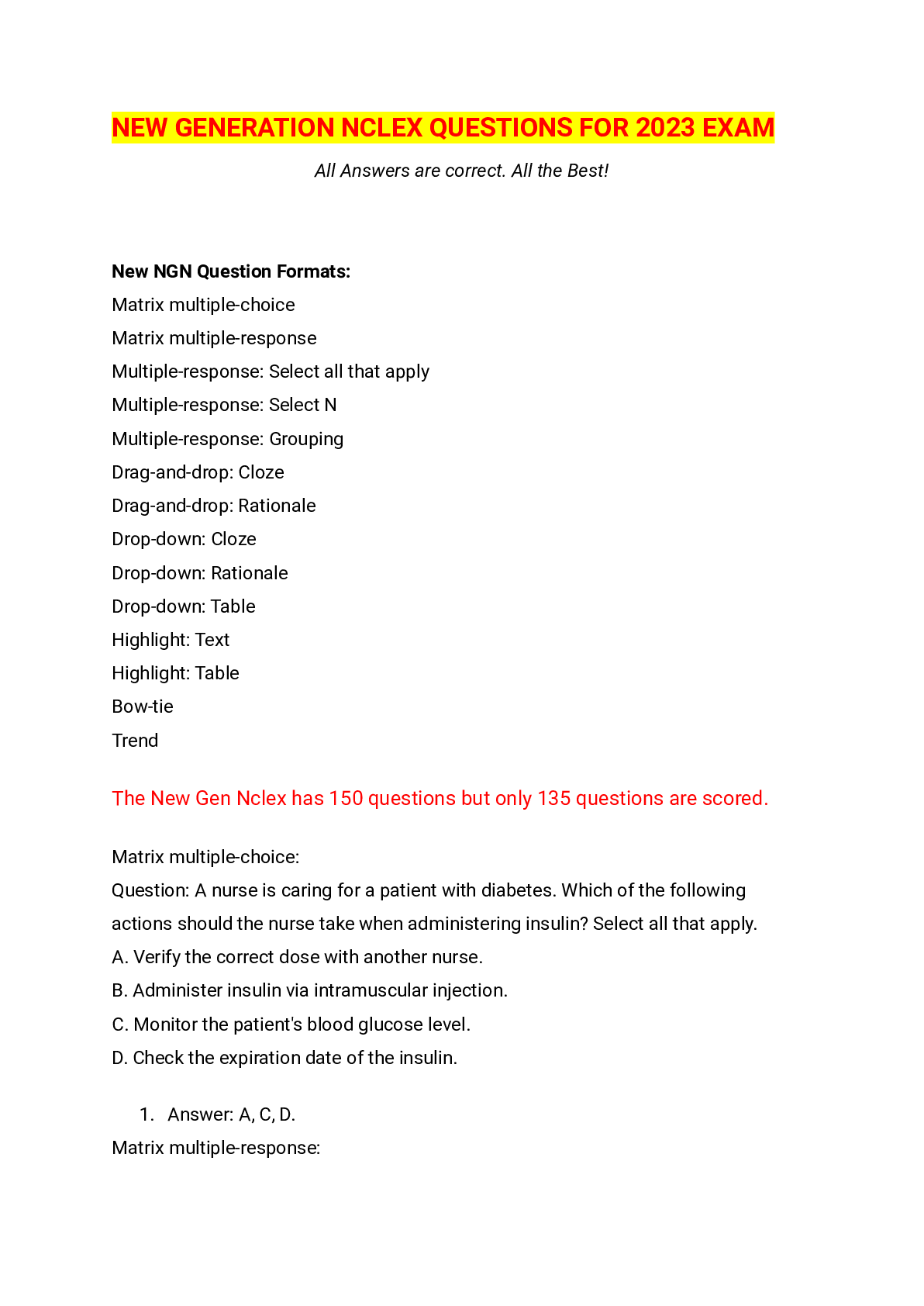
Reviews( 0 )
Document information
Connected school, study & course
About the document
Uploaded On
Oct 19, 2023
Number of pages
90
Written in
Additional information
This document has been written for:
Uploaded
Oct 19, 2023
Downloads
0
Views
88

